The Atlantic Provinces
David Ripley Ross
David Ripley Ross, “The Atlantic Provinces,” in Canadian Mormons: History of the Church of Jesus Christ of Latter-Day Saints in Canada, ed. Roy A. and Carma T. Prete (Provo, UT: Religious Studies Center; Salt Lake City: Deseret Book, 2017), 454-485.
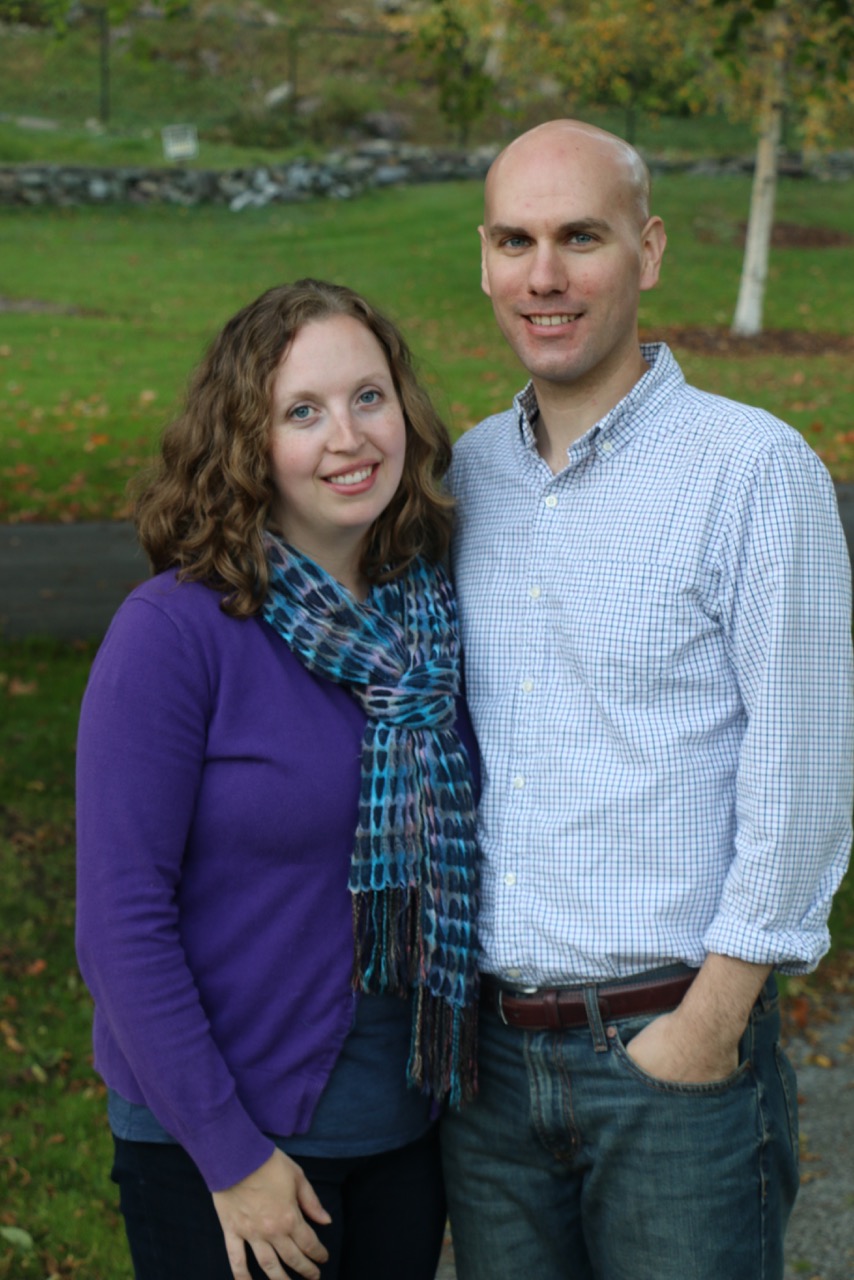
Born and raised in Wolfville, Nova Scotia, David Ripley Ross holds a BA (honours) degree in history from Acadia University, an MA degree in history from Simon Fraser University, and an MLIS degree from Dalhousie University. He has worked as a librarian at University of New Brunswick Saint John since 2007 and currently holds the position of Head of Learning and Research Services. He served as the bishop of the Saint John Ward, Saint John New Brunswick Stake, 2010–16. He and his wife, Aleisha, have four children: Elena, Duncan, Julianna, and Cara. (David Ross)
 Canada’s four Atlantic Provinces have a rich gospel heritage. Early missionaries made small numbers of converts in New Brunswick, Nova Scotia, and Prince Edward Island, but by 1855 almost all had migrated to Utah. Sustained missionary work began anew in New Brunswick in 1919, in Nova Scotia the year after, in Prince Edward Island in 1943, and in Newfoundland and Labrador in 1948. In 2015, after many years of missionary work, coupled with the efforts of faithful Church members, Atlantic Canada had many wards and branches, two stakes, and a magnificent temple.
Canada’s four Atlantic Provinces have a rich gospel heritage. Early missionaries made small numbers of converts in New Brunswick, Nova Scotia, and Prince Edward Island, but by 1855 almost all had migrated to Utah. Sustained missionary work began anew in New Brunswick in 1919, in Nova Scotia the year after, in Prince Edward Island in 1943, and in Newfoundland and Labrador in 1948. In 2015, after many years of missionary work, coupled with the efforts of faithful Church members, Atlantic Canada had many wards and branches, two stakes, and a magnificent temple.
The development of the Church in Atlantic Canada had its origin in the early days of the Church, when faithful missionaries, travelling “without purse or scrip,” made small numbers of converts in each of New Brunswick, Nova Scotia, and Prince Edward Island. By 1855, nearly all of these early converts, numbering more than two hundred, had joined the main body of the Church, and they eventually crossed the plains to Utah. Only a few scattered members remained behind.[1]
The foundation for the permanent establishment of the Church in the Atlantic Provinces was laid with the opening of the Canadian Mission in 1919, with headquarters in Toronto, and the arrival of stalwart missionaries who, by dint of sheer effort, obtained a foothold in Nova Scotia and New Brunswick. In the 1940s, missionaries began working sporadically in Prince Edward Island and, in 1948, came to Newfoundland. There were many setbacks, and vast distances proved an ongoing challenge. But slow and steady progress was made through the faith, dedication, and tenacity of missionaries and members. This laid the foundation for a rich harvest of souls in the 1970s and 1980s, which resulted in the formation of the Dartmouth Nova Scotia Stake in 1985 and the Saint John New Brunswick Stake in 1988. The culminating blessing was the dedication of the Halifax Nova Scotia Temple in 1999, which was the fulfillment of a dream. The temple has served as a spiritual anchor in the lives of the Saints in the Atlantic Provinces.
The Lay of the Land
The three Maritime Provinces of New Brunswick, Nova Scotia, and Prince Edward Island form a distinct geographical region of 133,851 square kilometres (51,635 square miles), nearly as large as Florida. Far removed from the others, the province of Newfoundland and Labrador has an area three times as big as the other three combined. The four Atlantic Provinces are relatively lightly populated, with a combined population of under 2.5 million.
The Appalachian Mountains dominate northern New Brunswick. Agricultural lands are located in the Saint John River valley and along the southeastern regions of the province. Because the province is heavily wooded, logging and pulp and paper have long been key industries. Shipbuilding has been an important industry along the seacoast. One-third of the people in New Brunswick are French speaking, descending from early French colonization, and the province is officially bilingual.[2]
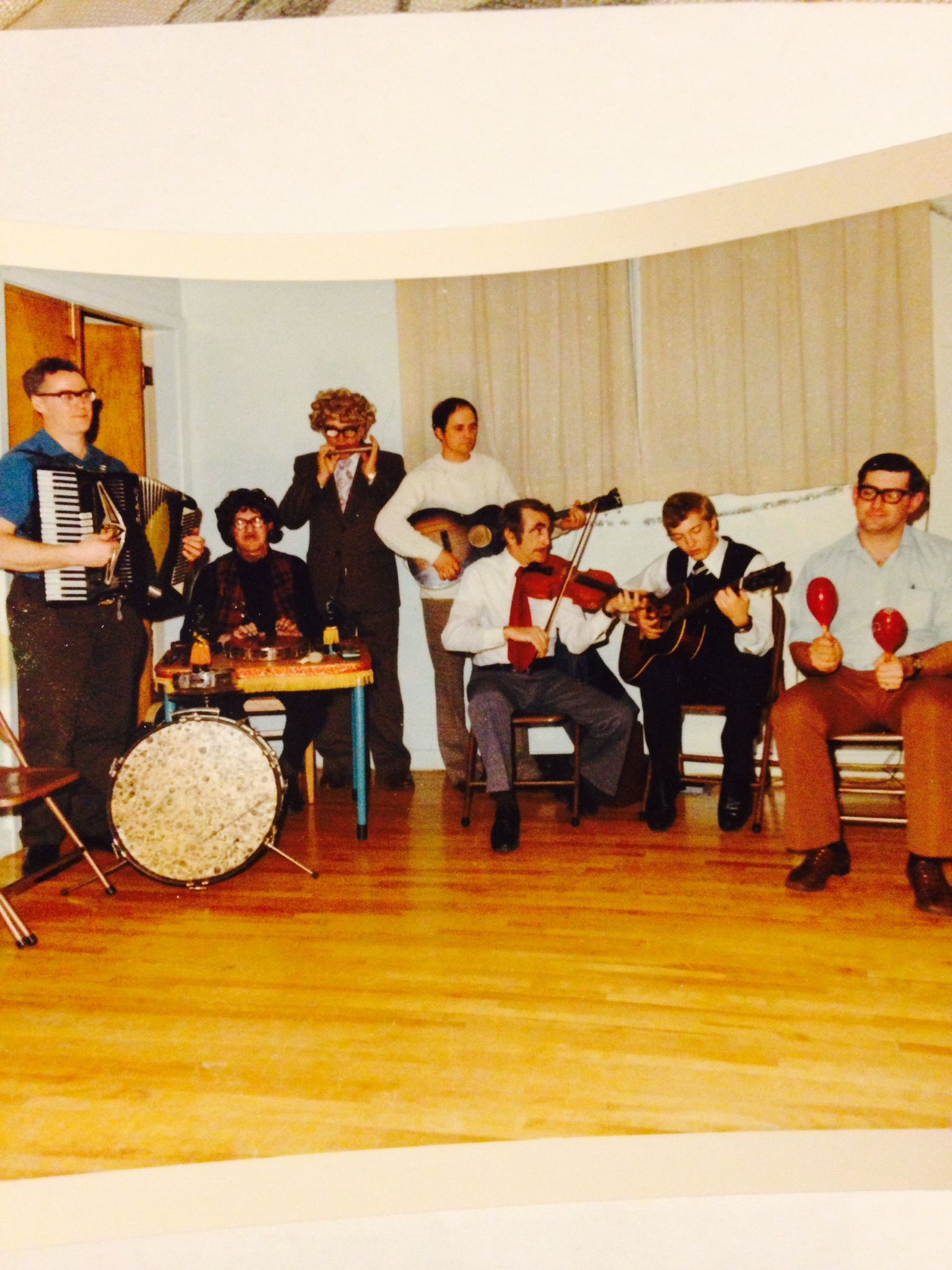 People from the Atlantic Provinces have a reputation for being sociable and welcoming. Music and dancing are part of the local culture, which has carried over into the LDS Church community. In this photo of the late 1960s or early 1970s, the band of the Saint John Branch is warming up for a branch party. Left to right: Wilfred Fox is playing the accordion; Harry Truswell, wearing a wig, is sitting behind an instrument he calls the “fantasia;” Harry Spragg, playing the harmonica, is also wearing a wig; Glen Cosman is on guitar; Bert Foley is playing the violin; a missionary, guitar; Ron Murray, maracas. In 2016, Spragg’s son, David A. Spragg, was the president of the Saint John New Brunswick Stake and Cosman was the stake patriarch. (Eleanor Hilchie)
People from the Atlantic Provinces have a reputation for being sociable and welcoming. Music and dancing are part of the local culture, which has carried over into the LDS Church community. In this photo of the late 1960s or early 1970s, the band of the Saint John Branch is warming up for a branch party. Left to right: Wilfred Fox is playing the accordion; Harry Truswell, wearing a wig, is sitting behind an instrument he calls the “fantasia;” Harry Spragg, playing the harmonica, is also wearing a wig; Glen Cosman is on guitar; Bert Foley is playing the violin; a missionary, guitar; Ron Murray, maracas. In 2016, Spragg’s son, David A. Spragg, was the president of the Saint John New Brunswick Stake and Cosman was the stake patriarch. (Eleanor Hilchie)
Nova Scotia, which includes Cape Breton Island, has many bays and estuaries and a first-rate harbor at Halifax, the capital city, fitting it well as a naval base and centre for international shipping. Nearly surrounded by water, Nova Scotia has forty to fifty-five inches of precipitation each year, an average of 196 days of fog annually, and frequent severe storms—even hurricanes.[3] Nova Scotia’s economy has been mostly resource based, including fishing, forestry, mining, and agriculture, but in recent years it has become somewhat more diversified.
Beautiful Prince Edward Island is a picturesque land of rolling hills and lighthouses, with salt marshes and miles of beaches. Iron oxide gives the soil its characteristic red color.[4] Agriculture is the principal industry, and Prince Edward Island produces 25 percent of the potatoes grown in Canada.[5] The Island is small, less than 225 kilometres (150 miles) from one end to the other, and there is no place on the island that is more than sixteen kilometres (ten miles) from the ocean.[6]
Newfoundland and Labrador is a large province on the eastern edge of the North American continent consisting of the island of Newfoundland—sometimes nicknamed “the rock,” because of its rocky terrain—and the mainland segment of the province, Labrador, located to the east of Quebec. Newfoundland, which joined the Canadian Confederation in 1949, is isolated from the other Atlantic Provinces. Travelling on the surface from Nova Scotia to Newfoundland entails a seven- to eight-hour ferry ride (in good weather) from North Sydney, Nova Scotia, to Port aux Basques, Newfoundland. The economy of Newfoundland and Labrador has long been based on fishing, forestry, and hydroelectric power generation, but in recent times, with the decline of the fishing industry, other industries such as mining, tourism, and offshore petroleum, have become more prominent.[7] Four United States military bases were established in Newfoundland and Labrador in 1941 and operated until the 1960s and 1970s.[8]
The intrinsic challenges of the region have tested the mettle of its inhabitants. Vast distances, cold winters, and a sometimes stormy climate, characteristic of all the Atlantic Provinces, have been formidable challenges to the establishment and administration of the Church. The problem of distances in Newfoundland is particularly acute, as the main settlements on the east and west coasts are separated by nearly eight hundred kilometres (five hundred miles) of largely uninhabited wilderness. The economy of the Atlantic Provinces, based largely on primary industries, has often been precarious, and major shifts have had significant consequences for Church development.
Beginnings, 1832–55
The early history of the Church in Atlantic Canada has been treated in detail in the chapter, “Early Preaching in Eastern Canada, 1829–77.” Only a few highlights of that history, which provides a rich heritage of faith for Latter-day Saints in the Atlantic Provinces, will be repeated here. This history began when Lyman S. Johnson was called, in a revelation to Joseph Smith in January 1832, to preach the gospel in the “eastern countries” (see D&C 68:1–12; 75:14). After working in several eastern American states, Johnson, accompanied by John Heriot, preached the restored gospel in Nova Scotia in 1832 or 1833.[9] Over the next two decades, missionaries came in small numbers in sporadic missions and, despite the lack of an organized missionary effort, established small pockets of Saints in all three Maritime Provinces.
Some missionaries had notable success. In 1836, Lyman Johnson, Milton Holmes, and James Heriot preached the gospel in Sackville, New Brunswick, a small town near the Nova Scotia border, where they baptized eighteen people and established a branch—the first in the Maritime Provinces.[10] Among their converts was Sarah Ann Reynolds Merrill, mother of future Apostle Marriner W. Merrill.[11] Several years later, in 1841 or 1842, Joseph Russell, a successful shipbuilder, and his wife were baptized near Miramichi, New Brunswick.[12]
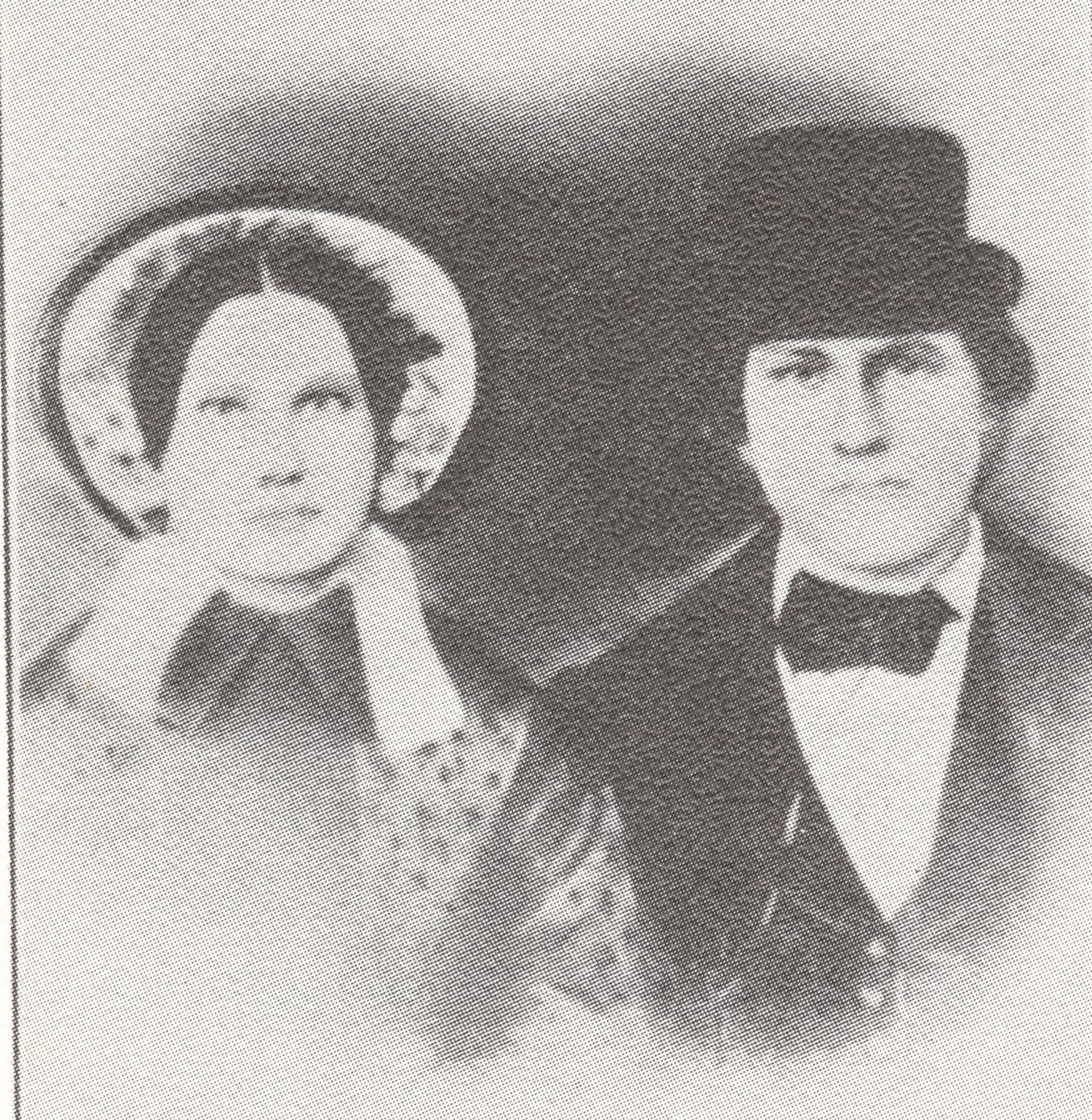 Marriner W. Merrill (1832–1906) was baptized in Sackville, New Brunswick, in 1852 and migrated to Utah in 1853. He later served as president of the Logan Temple and as a member of the Quorum of the Twelve. He is pictured here in 1853 with his wife Sarah Ann Atkinson, also a Canadian convert, daughter of the Sackville branch president.[13] (Melvin Clarence Merrill)
Marriner W. Merrill (1832–1906) was baptized in Sackville, New Brunswick, in 1852 and migrated to Utah in 1853. He later served as president of the Logan Temple and as a member of the Quorum of the Twelve. He is pictured here in 1853 with his wife Sarah Ann Atkinson, also a Canadian convert, daughter of the Sackville branch president.[13] (Melvin Clarence Merrill)
Jesse W. Crosby and Benjamin Brown also had notable success in New Brunswick. They baptized forty-seven people in York County, New Brunswick, and organized two branches, amidst intense opposition. Brown was severely beaten as the victim of mob violence, and was only protected from the further brutality of the mob by the intervention of an influential recent convert, Daniel Shelton.[14]
Missionaries from the United States typically moved overland from adjoining eastern states, while their Canadian converts often did missionary work in nearby settlements. For example, Nova Scotian Robert Dickson of Onslow (near Truro) served a mission in his native province and won converts in the Halifax area between 1842 and 1845, despite significant opposition. John Skerry, the first president of the Halifax Branch after it was established on 18 November 1843, was instrumental in introducing the gospel in Prince Edward Island in 1844 or 1845, baptizing twelve people at Bedeque and organizing a branch there. Most of the converts at Bedeque were relatives of John Ellison Maxfield.[15] The family of John Poole responded to the gospel message in Charlottetown in about 1844, and although John Poole died before he could be baptized, his wife, Mary, and other family members joined the Church and gathered with the Saints in Utah.[16]
Small pockets of converts were grouped in the Halifax area and in PEI. At a conference in Halifax held on 10 December 1845, it was reported that the Halifax Branch had sixteen members: Preston had six; Popes Harbour, eight; Sheet Harbour, two; Onslow, three; and Bedeque, twelve. There were also members living in Charlottetown, PEI, by May 1847.[17]
In 1853, at a time when many Saints were moving west, nineteen-year-old Joseph Millet was travelling east from Utah to Nova Scotia to serve a mission, “without purse or scrip.” During the summer of 1853, he preached in various places from Yarmouth to Cape Breton Island, organizing a branch in Gabarus in June. His journal provides a fascinating look at life as a missionary in mid-nineteenth-century Nova Scotia, and records, in addition to much walking and a mixed reception of warm welcome and scorn, numerous miracles and answers to prayers. [18]
 The first page of the journal that Joseph Millet kept while serving as a missionary in Nova Scotia in 1853. (Arnon Livingstone)
The first page of the journal that Joseph Millet kept while serving as a missionary in Nova Scotia in 1853. (Arnon Livingstone)
Gathering to Zion
The call to gather to Zion was extended to the Maritime Provinces, as elsewhere. On 28 January 1846, priesthood leaders met in Halifax to plan how to lead their members west to join the Saints migrating to what would later become the state of Utah.[19] On 15 May 1846, they decided to combine the branches in Nova Scotia and Prince Edward Island under a single branch presidency to make it easier to coordinate travel plans.[20] In June 1850, the three Maxfield brothers of Bedeque—John, William, and Richard—and their families left for Utah.[21]
The history of the Saints was not without difficulty. In August 1851, serious contentions arose among Church members still in Nova Scotia, some having joined the Strangite movement, making it necessary for Orson Hyde, the President of the Quorum of the Twelve, to send two missionaries to Halifax to resolve the situation.[22] The missionaries were able to restore order to the branch, but only after excommunicating several members, some of whom were later readmitted, and installing a new branch president.[23] A few weeks after the missionaries’ visit, Apostle Franklin D. Richards instructed Jesse W. Crosby to leave his mission in the British Isles and proceed to Nova Scotia both to preside over the Saints and to help push along the emigration efforts.[24] In the summer of 1853, Crosby and William Atkinson (of Sackville, NB) led a group travelling by wagon from Nova Scotia and New Brunswick to Utah.[25]
On 12 May 1855, another group of Saints set sail from Halifax to Boston aboard the barque Halifax, from whence they travelled by train and steamer as far as Kansas and then by wagon to Utah.[26] Shortly after this group left, a few more of the Halifax Saints departed for Utah.[27] By the end of 1855, there were no longer any organized units of the Church in the Maritimes.
Faith of the Early Saints
One historian writing about the early history of the LDS Church in Nova Scotia, largely from non-LDS sources has cast doubt on LDS membership numbers from this time, because, in his words, “apostasy was rife in the early church and membership was often not long-lived. The initial enthusiasm of many new converts frequently evaporated under the intense pressure of family scrutiny and community cynicism.”[28] While it is true that new converts, unschooled in gospel principles, sometimes fell into difficulty, and there was sometimes serious internal conflict within the little branches, the number of people who immigrated to Zion from the Maritime Provinces—approximately two hundred according to recent research on their overland travels[29]—would suggest that significant numbers of early converts remained faithful. The very small numbers of Latter-day Saints identified in subsequent Canadian census reports in the Maritimes would seem to bear this out, even making allowances for those who may no longer have identified themselves as Latter-day Saints. The faith and dedication of early missionaries and members in the Maritime Provinces serve as a heritage to inspire present-day Saints as they face the varied challenges unique to their time.
The Lonely Few, 1855–1919
After 1855, few Latter-day Saints remained in the Maritimes. The 1871 Census of Canada records that there were only sixteen Mormons in Nova Scotia that year.[30] Only four of these sixteen individuals appear again in the 1881 Census, and only three of these still identify themselves as Mormons, but three new Mormons also appear.[31] In New Brunswick, the 1871 Census lists three Mormons[32] and the 1881 Census shows none.
Beyond their names and locations, little is known about the small number of Saints who opted to remain in Atlantic Canada rather than migrate to the West. We know that some stayed for personal reasons. For example, David Booth Shelton remained in Fredericton because he was in poor health and wanted to stay with his daughter Lucy.[33] Sarah Ann Reynolds Merrill remained in Sackville (NB) to be with her husband who had not joined the Church.[34]
The 1891 and 1901 censuses of Nova Scotia list a number of people with the religion “Saints” and “L.D.S.” living in Hants, Kings, and Cumberland counties. The largest of these groups was in Hants County, with forty-seven individuals recorded in the 1891 census and twenty-five in the 1901 census, mainly concentrated in the Rawdon-Uniacke and Brooklyn areas.[35] Research has shown that this group of people were actually members of the Reorganized Church of Jesus Christ of Latter Day Saints (RLDS). A deed registered in the nearby town of Windsor in September 1889, for example, shows that George W. Blakeslee, trustee for the Reorganized Church of Jesus Christ of Latter Day Saints of Calieu, Michigan, purchased land for the group in South Rawdon on 3 March 1889. The group does not appear to have remained long in the area, but they did construct a building that was known in the community as the “Mormon Temple.”[36]
Other pockets of “Saints” and “LDS” reported in the 1891 and 1901 Canadian Census in the Maritime Provinces were likely RLDS, including those who built a “Mormon Temple” on New Brunswick’s Grand Manan Island in the 1870s. This building later burned down and was replaced by a Catholic chapel.[37]
Between 1855 and the turn of the century, only two known LDS missionaries served in Atlantic Canada. One was Robert Dickson of Onslow, NS, the same man who converted several people in the Halifax area between 1842 and 1845 and later migrated to Utah. In 1871, he obtained Brigham Young’s permission to go to Nova Scotia and spent about seven months that year preaching in the Truro area before having to return to Salt Lake City because of illness.[38] There is no record that he baptized anyone on this trip. John A. Mayer, of the Eastern States Mission (established in 1893), also laboured in Nova Scotia, for there is a record that on 8 November 1898 he baptized Mrs. Ruth Ann Murgatroyd at East River, Halifax County.[39]
Sporadic Missionary Work Resumed after 1906
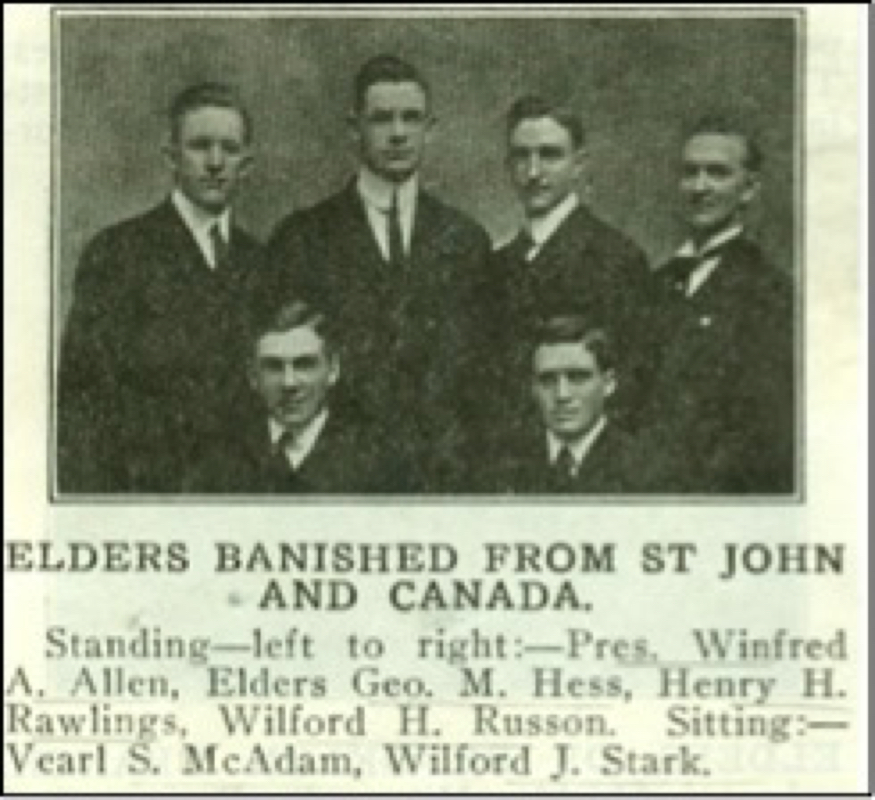 These six missionaries, labouring in 1915 in Saint John, New Brunswick, were charged and convicted of operating a business without a license. Given a choice between paying a significant fine, serving a jail sentence, or leaving Canada, they opted to continue their work in the New England states. This clipping was published in Liahona, the Elders’ Journal in 1915.
These six missionaries, labouring in 1915 in Saint John, New Brunswick, were charged and convicted of operating a business without a license. Given a choice between paying a significant fine, serving a jail sentence, or leaving Canada, they opted to continue their work in the New England states. This clipping was published in Liahona, the Elders’ Journal in 1915.
According to Eastern States Mission reports, there were missionary efforts in Nova Scotia and New Brunswick in 1906[40] and again in 1911.[41] In the 1910s, missionaries visited Blackville, New Brunswick, and taught Charles George Stephens. Stephens did not gain a testimony until after the missionaries left the area, but he held regular Sunday School classes after his conversion where he taught “the truths of Mormonism” to his neighbours and developed a bit of a following. Stephens reestablished contact with the Church and was baptized in 1920, although none of his neighbours joined him in doing so.[42]
In 1914, after the outbreak of World War I, two American missionaries were serving in Amherst, NS, when they were arrested as German spies. They were later released after appealing to the mayor.[43] But the following year, six missionaries in Saint John also met with trouble and were forced to return to the United States after being threatened with imprisonment for carrying out business without a license.[44]
A New Beginning, 1919–45
In 1919, the Church created the Canadian Mission with headquarters in Toronto to oversee missionary work in all Canadian provinces east of Saskatchewan and appointed Nephi Jensen as the first mission president.[45] This would be a major turning point for the Church in Atlantic Canada, as from this point onward, the region would receive far more missionary attention than it had in the past.
On 19 October 1919, Jensen created the New Brunswick Conference (District) and sent two missionaries to Saint John to preside over the work. On 6 February the following year, he organized the Nova Scotia Conference (District) and sent missionaries to Halifax, Fredericton; and Moncton, New Brunswick.[46]
Local Opposition
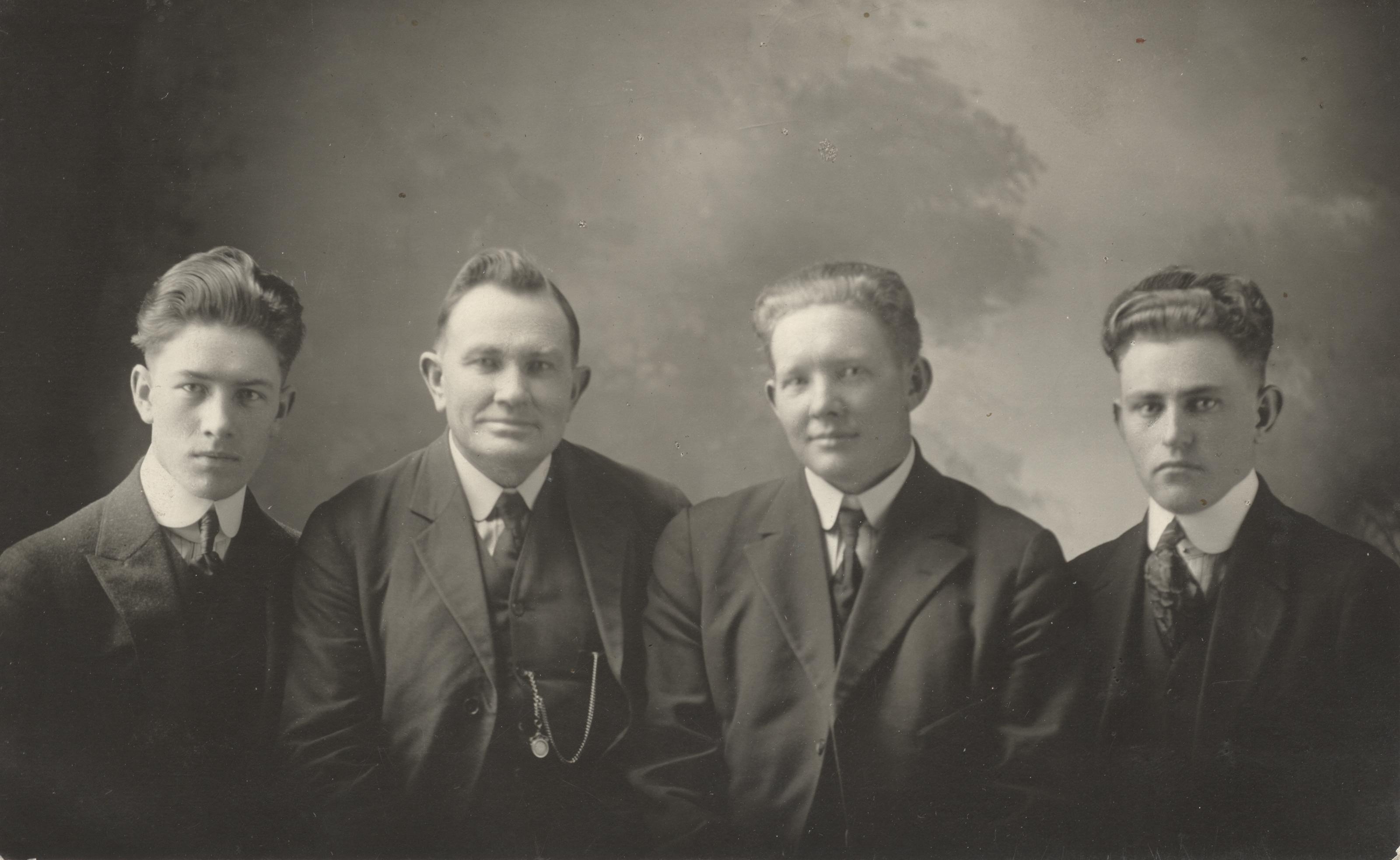 The four missionaries who opened the Nova Scotia Conference of the Canadian Mission in February 1920, L to R: Mark E. Petersen (later an Apostle), Andrew Sproul (conference president), Henry L. Baker, and Hugh A. Reid.[56] (Church History Library)
The four missionaries who opened the Nova Scotia Conference of the Canadian Mission in February 1920, L to R: Mark E. Petersen (later an Apostle), Andrew Sproul (conference president), Henry L. Baker, and Hugh A. Reid.[56] (Church History Library)
In Moncton, the missionaries received permission to hold street meetings. On 24 July 1920, the missionaries, along with President Jensen, spoke to a large crowd on Main Street and, the following day, addressed an audience of four hundred people at the Moncton Opera House.[47] The cities of Saint John and Fredericton were not as welcoming, and, in fact, Moncton also later denied permission for a time.[48] In the spring of 1920, the mayor of Saint John told the missionaries that police would break up any street meetings they tried to hold.[49] Missionaries in Fredericton were also denied the right to organize street meetings or tract, although they continued to hold meetings in rented halls.[50]
Likewise, in Halifax, the city council in 1920 repeatedly refused the missionaries’ requests to proselytize.[51] The Halifax City Council was influenced by Clarendon Lamb Worrell, the Anglican Archbishop of Nova Scotia, who wrote a letter to the Council that was published in the Halifax Herald and that reads in part: “It would be a great mistake for the council to accede to the requests of the Mormon society. It would not be in the interests of the city to give its streets for the propagation of a society of doubtful reputation and unsavory history.”[52] The missionaries requested to hold street meetings across the harbour in Dartmouth, but this was also denied because of opposition from the local clergy,[53] although the Dartmouth city council did reverse its decision several months later.[54] The Halifax City Council did not grant the missionaries permission to proselytize until May 1928.[55]
Gaining a Foothold
Despite the opposition, the elders managed to find some success. Elder Andrew Sproul, president of the Nova Scotia Conference, reported that they had “a number of warm friends in Halifax and many opportunities of holding cottage meetings.”[57] In October 1920, Elders Henry Baker and Hugh Reid received a warm welcome at the home of Ruth Ann Murgatroyd of Stellarton, near New Glasgow, who had been baptized twenty-two years earlier and who was the only known member of the Church in Atlantic Canada at the time.[58]
Murgatroyd would not remain the only member for long, though, as Andrew and Beatrice Meeter were baptized in Halifax on 31 July 1921.[59] The Meeters’ baptisms took place eighteen months after the first elders of the Canadian Mission arrived in Halifax. When Mark E. Petersen, who was among those first missionaries and who later served as an Apostle from 1944 to 1984, heard the news of the baptism, he wrote in his journal: “At last. This is the first baptismal held since Nova Scotia became a conference. These are the first fruits of our labors. You may well understand with what emotions of joy and thanksgiving we received this word.”[60] Eleven other baptisms followed shortly thereafter, including the baptisms of Calvin and Bessie Fredericks.[61]
Expanded Missionary Efforts
In the months and years that followed, the missionaries expanded their efforts into new areas. In addition to the cities already noted, they opened areas in Windsor in July 1920[62] and New Glasgow in October the same year.[63] In New Brunswick, Milltown (near St. Stephen) was opened in September 1921 and Sussex by November 1922; in Nova Scotia, Yarmouth was opened in May 1926,[64] Truro by September 1927,[65] and Bridgewater in October 1927.[66] As early as 1921, missionaries also engaged in what they called “country work” during the summers, which consisted of travelling through rural areas, “without purse or scrip,” preaching and visiting scattered members.[67]
Throughout the 1920s, there were usually between two and six missionaries altogether labouring in New Brunswick and Nova Scotia. The work was challenging, and it was not unusual for missionaries to go their entire missions without a single baptism. Elder Mark E. Petersen, for instance, did not baptize anyone during his mission from 1920 to 1922. However, baptisms that occurred helped generate interest. In December 1923, for example, nearly one hundred people gathered outside of Saint John to see two people baptized in a frigid lake, and a local newspaper reporter wrote that the event was “getting back to the true religion of Christ when people would be baptized in the bible manner in a lake of freezing water.”[68]
Organizing the Saints
As the number of members gradually increased, Church programs such as Sunday Schools and Relief Society groups were instituted. Missionaries started holding regular Sunday School meetings in Halifax in November 1921, and missionaries in Saint John reported in May 1924 that Sunday School classes there had grown to the point that they needed to find a larger place to meet. Joseph Quinney Jr., who replaced Nephi Jensen as the president of the Canadian Mission, organized Relief Society groups in Saint John on 23 November 1923 and in Halifax on 2 February 1926.[69]
In June 1925, Joseph Fielding Smith of the Quorum of the Twelve visited Saint John and Halifax with his wife Ethel and the president of the Canadian Mission.[70] Smith was the first of ten Apostles, including three future prophets (Joseph Fielding Smith, David O. McKay, and George Albert Smith), to visit New Brunswick and Nova Scotia between 1925 and 1937.[71] This many visits from Apostles in a twelve-year period is remarkable. In the twenty-first century, with a much larger worldwide Church, members in the Atlantic Provinces consider themselves fortunate if one Apostle visits the region in ten years. There does not appear to be a particular reason why this period saw so many visits, but it is known that the Apostles were usually accompanied by the mission president and always spoke at special meetings held for members.[72]
Official membership totals for Atlantic Canada are not available until 1965, but attendance figures for meetings during Apostles’ visits provide some clues as to the size of the Church in the region throughout the 1920s and 1930s. When David O. McKay visited in 1929, twenty-eight people heard him speak in Halifax, and thirty people attended a meeting at which he spoke in Amherst.[73] When Apostle Melvin J. Ballard visited Saint John on 27–28 June 1931, fifty-seven people turned out to hear him speak,[74] but when he returned to the city three years later, only thirty-three people attended.[75] There were still no known members living in Prince Edward Island or Newfoundland at this point.
Impact of the Great Depression
Because of the Great Depression, the number of missionaries serving in Atlantic Canada decreased in the 1930s. In the first years of the decade, there were only two missionaries in all of New Brunswick. When John Bluth, the president of the Canadian Mission, visited Saint John on 16 March 1933, he proclaimed that “troublesome times are here, laborers in the Mission field are few and may become fewer.”[78] Six months after making this statement, he withdrew all missionaries from the two provinces and reassigned them to serve in Maine.
Although the plan was to have the missionaries return in the spring of 1934, they remained absent for almost all of the next three years.[79] During this time, the Church was left in the hands of the local members. Many of the responsibilities in Saint John fell to Harry and Cora Truswell, who had just returned to the city after being in Alberta and Utah for nearly a year.[80] Clive J. Cooper, a missionary and president of the Maine District, wrote at the time, “We feel that they [the Saint John members] are capable of conducting the organizations of the branch satisfactorily, and pray for their success in taking over this responsibility.”[81]
On 12 August 1934, the Saint John Sunday School became the Saint John Branch with Harry Truswell as its first president.[82] This change in status was significant because it meant the local leaders would now have more authority to oversee and operate more aspects of the Church program. It also marked the first time since 1855 that there was an official branch of the Church in Atlantic Canada.
Missionaries returned to New Brunswick and Nova Scotia in 1936, but the numbers serving there remained low throughout the rest of the 1930s, and there were periods, usually during winter months, when there were no missionaries at all. While in New Brunswick in 1936, missionaries taught fourteen-year-old Leatha Boudreau, who was baptized, along with two of her cousins, on 12 September. Leatha had learned about the Church a few years earlier from her grandfather’s cousin John W. Giggie of Moose Mountain, New Brunswick, who had joined the Church in 1930, and who held cottage meetings in his home whenever the missionaries visited.[83]
In September 1937, the Church created the New England Mission (with headquarters in Cambridge, Massachusetts), which from then until 1973 assumed responsibility for missionary work in Atlantic Canada. Two months later (on 9 November), the new mission president, Carl F. Eyring, created the Canadian District, composed of the three Maritime provinces, and appointed J. Glen Longhurst, a missionary, as district president.[89]
In the absence of local Church units, many members had to fend for themselves. In February 1939, Longhurst recorded that “Due to the fact that our district is exceedingly large—about 600 miles in length—we have been unable to visit many of the members of the Church during the past few winter months. However, we have been able to keep in touch with most of them through correspondence, and happily report that most of them are well.”[90]
In the summer of 1940, the new district president, Eldred L. Dance, and his companion, Darwin F. Perkins, travelled 1,600 kilometres (1,000 miles) to visit members around Nova Scotia. Afterward, Dance reported: “Our members there are widely scattered and as a result have little contact with the Church. That many of them, living under such conditions remain faithful and loyal to the high standards and principles of the Church, is positive indication of the good testimony of the Gospel which they possess.”[91] He also reported that they were faithfully holding meetings where they could and that their tithing records were “excellent.”[92]
The War Years
Just as the Great Depression had done, World War II caused a serious shortage of young men available to serve full-time missions. By 1941, there were only two missionaries covering the entire provinces of New Brunswick and Nova Scotia.[93]
The next year, however, on 14 September, the Church sent two missionaries to Prince Edward Island. Their visit lasted only four days, but it was significant in that it marked the first time in about ninety years that missionaries had been there. They returned to PEI in November to explore the possibility of establishing a more permanent presence and held a meeting in Summerside that fifty nonmembers attended. They also contacted a young married couple from western Canada who were the only Latter-day Saints in PEI.[94]
In April 1943, the mission president, William H. Reeder Jr., assigned two missionaries to serve in PEI, and they decided to base themselves in Summerside. Before long, six Church members began joining them for Sunday services; four were air force pilots stationed there during the war, and the other two were the spouses of two of these officers. Sometimes the pilots flew long distances to be at the meetings.[95]
The missionaries also found a young schoolteacher named Irene Dorothy Wyand who was very interested in the gospel, but who worried that joining the Church would mean her family would disown her and that she would lose her job. Later that year, she decided to join, regardless of the consequences. She travelled to Saint John to be baptized in November 1943 before moving on to Ontario.[96]
During the war years, attitudes towards the missionaries became so negative on Prince Edward Island that the elders were unable to continue their work and were withdrawn in 1943. They had been rejected and ridiculed when they tried to donate blood, and rumours circulated that they were German spies.[97]
In the spring of 1943, the missionaries in Saint John were also accused of being German spies, and this time the Royal Canadian Mounted Police became involved. In the end, the RCMP decided not to pursue the charges, but they did inform the elders that they were required to register for Canadian compulsory military service, adding though that they would receive an exemption as ordained ministers and would not be called up. When the missionaries registered as instructed, they were ordered to report for military service. They made various appeals for an exemption, including one to the Parliament of Canada, but every attempt failed and, as a result, President Reeder felt compelled to withdraw all of his missionaries from the country. On 18 January 1944, he wrote, “For the first time in the history of the Church, missionaries were refused the right to labor in Canada.”[98]
On 12 July 1944, President Reeder visited Nova Scotia and organized the Nova Scotia District with local leaders. At the organizational meeting in Halifax, Nelson A. Smith was called as president, with Nelson H. Parker as first counselor and Grenfell Smith as clerk.[99] This was done to provide leadership and structure to the Church members in the absence of the missionaries.
President Reeder discovered on a visit to the Saint John Branch from 24–27 November 1944 that conditions there had become “quite unsatisfactory.” The biggest problem was a spirit of contention and disunity, but the branch president, James Lowe, was also so ill that he could not provide the leadership the branch needed. By 20 May 1945, President Lowe’s health had become so poor that he had to be released, and two missionaries were assigned to lead the branch instead.[100] (This is the first record of missionaries being back in New Brunswick after they were removed the previous year.) When they reported a few months later that contentions had worsened and that they no longer felt comfortable bringing investigators to meetings, President Reeder decided to close the branch in August 1945.[101]
Establishing a Solid Foundation, 1946–60
By 1946, missionaries were back in Nova Scotia and New Brunswick. On 23 March 1947, the Halifax Branch was organized, and the Saint John Branch was reestablished in May.[102] In 1948, Newfoundland was opened to missionary work, one year before becoming the last province added to the Canadian confederation. Missionary work in Prince Edward Island, however, did not resume until 1958.
Nova Scotia
On 18 February 1946, two missionaries, D. W. Scott and G. S. Floyd, reopened the Nova Scotia District. Two other missionaries joined them on 20 May. They laboured in Halifax, Wolfville, Windsor, and New Glasgow. On 9 February 1947, Church members in Halifax gathered for the first time in the School for the Blind, a newly acquired meeting place, which it was believed would “help the work considerably.” A few members attended that day who had not attended for some time.[103]
The Halifax Branch was organized at a conference on 23 March 1947, with Nelson Parker, a local member, as branch president. Parker was, at that time, also serving as a counselor to Nelson Smith in the district presidency. Douglas H. Johnson was appointed first counselor to Parker. This was the first branch established in Nova Scotia in nearly one hundred years! Present at the conference were nine adult members, seven children, and two investigators. Doris Englehart was, at that time, serving as Relief Society president; Calvin Fredericks was Sunday School superintendent; and Bessie Fredericks was Primary president.[104]
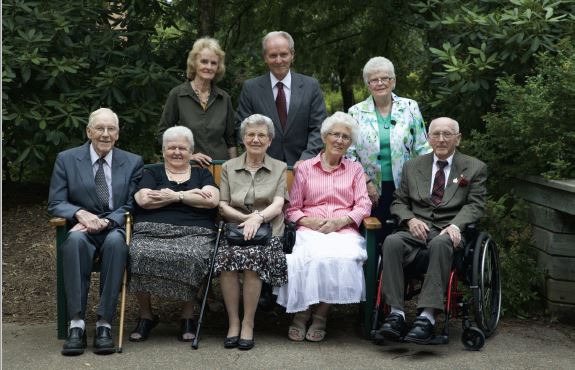 This photo, taken in 2014, shows several early Maritime converts who have made great contributions to the Church. The year following each name indicates the year of baptism. Back row, left to right: Edith Smith (1950), Glen Parker (1949), and Gladys Moses (1953); front row, left to right: Aubrey Fielden (1953), Thelma Fielden (1953), Joan Noreen Renshaw (1934), Charlotte Aalders (1956), and Wilbur Moses (1938). (Arnon Livingstone)
This photo, taken in 2014, shows several early Maritime converts who have made great contributions to the Church. The year following each name indicates the year of baptism. Back row, left to right: Edith Smith (1950), Glen Parker (1949), and Gladys Moses (1953); front row, left to right: Aubrey Fielden (1953), Thelma Fielden (1953), Joan Noreen Renshaw (1934), Charlotte Aalders (1956), and Wilbur Moses (1938). (Arnon Livingstone)
The wartime expediency of a member-led district ended on 6 July 1947, when, at a district conference in Halifax presided over by S. Dilworth Young, Nelson A. Smith was released as district president, along with his counselor Nelson Parker; D’Monte W. Coombs, a missionary, was appointed as the new district president.[105] S. Dilworth Young was then serving as both president of the New England Mission and as a member of the First Council of the Seventy.[106]
President Young returned to Nova Scotia in July 1949, accompanied by Milton R. Hunter of the First Council of Seventy. On 2 July, they met with missionaries and witnessed three convert baptisms in Halifax. The following day, they held a meeting for Church members in Halifax, with forty in attendance. On 5 July they held an evening meeting at Glace Bay, with fifteen people present.[107]
In Halifax, Evelyn Conrad joined the Church in 1952, along with her aunt Lillian Jackson Umlah. Conrad (later Roberts) later recalled that there were about twenty members attending the Halifax branch at that time. She considered moving to Utah after her baptism but was counselled to stay and build up the Church where she was, which is precisely what she did.[108]
Aubrey and Thelma Fielden of Dartmouth were baptized on 12 April 1953 and went to work right away serving in the Church. In fact, Aubrey was called as the first counselor in the Halifax branch presidency only one year after his baptism and as the president of the branch just three years later.[109] The Halifax branch gained Wilbur and Gladys Moses in 1955 after they moved to Dartmouth from Washington, DC.
Both the Fieldens and the Moseses served faithfully in numerous callings in the years ahead and have many descendants who are members of the Church living in Atlantic Canada today.
On 25 June 1958, Elder Mark E. Petersen of the Quorum of the Twelve, who had been in the first contingent of missionaries sent to Halifax in 1920, visited Dartmouth, Nova Scotia, to participate in the groundbreaking ceremony for the first LDS meetinghouse in that province.[111] The building, located at 88 Slayter Street, was completed in January 1959.[112]
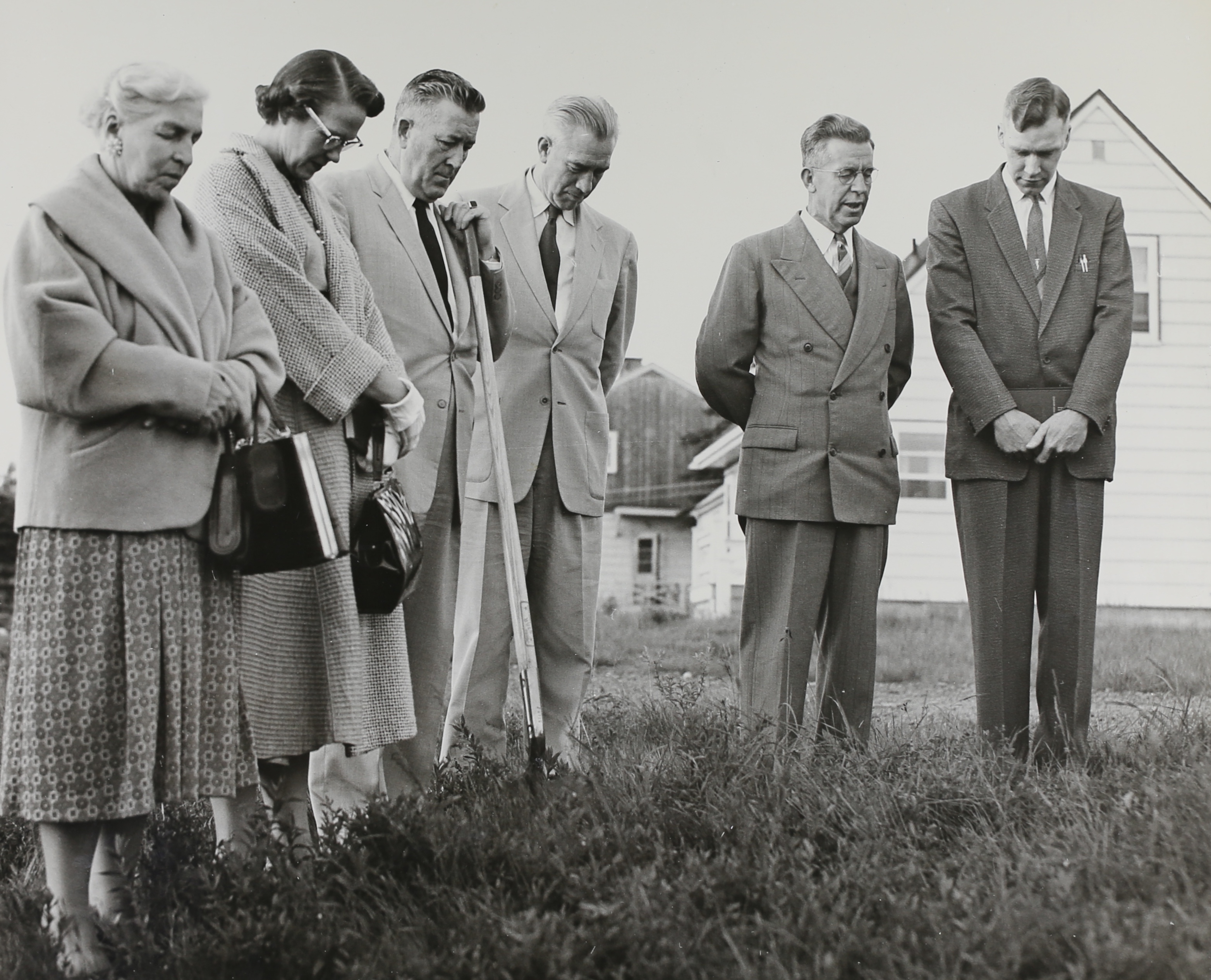 Nelson Smith, former district president, offering a prayer at the sod-turning ceremony for the Halifax Branch meetinghouse, the first LDS meetinghouse in Nova Scotia, in June 1958. Left to right: Emma Marr Petersen, Margaret Romney Jackson, Junius M. Jackson (president of the New England Mission), Mark E. Petersen (Quorum of the Twelve), Nelson Smith (president of the Kentville Sunday School), and Aubrey Fielden (president of the Halifax Branch). (Aubrey Fielden)
Nelson Smith, former district president, offering a prayer at the sod-turning ceremony for the Halifax Branch meetinghouse, the first LDS meetinghouse in Nova Scotia, in June 1958. Left to right: Emma Marr Petersen, Margaret Romney Jackson, Junius M. Jackson (president of the New England Mission), Mark E. Petersen (Quorum of the Twelve), Nelson Smith (president of the Kentville Sunday School), and Aubrey Fielden (president of the Halifax Branch). (Aubrey Fielden)
New Brunswick
At the same time the Church was being reestablished in Nova Scotia, the branch in Saint John, NB, suffered another setback. On 31 October 1948, President Young announced that, as a result of continued dissension, the branch would once again have to be discontinued and revert to the status of a Sunday School.[113] Some positive developments did come that year, though, as Lorne and Margaret Grace (née Henderson) Duplisea and their children Gerald Hugh and Ronald Lorne were baptized in Fredericton on 6 July 1948, along with Charles and Mildred Todd. The following year, Lorne’s sister, Lena Minnie Cosman’ her husband, John; and their children Betty Lois, Glendon Laverne, and Lorna Grace Marlene were baptized in Saint John on 17 January 1949.[114] The Cosmans have many descendants who have contributed, and continue to contribute, to the Church in New Brunswick.
The Saint John Branch was reestablished on 9 June 1953, with Ernest D. Phippen appointed to serve as branch president. The sixty-nine-year-old Phippen and his wife had recently arrived in New Brunswick as full-time missionaries.[115] The following year, on 30 May, the Fredericton Branch was established with forty-eight members.[116]
In 1955, the construction and dedication of the first LDS-owned meetinghouse in Atlantic Canada took place in Saint John, New Brunswick. Ground for the building, located at 531 Dunn Avenue, in Lancaster (which is now part of Saint John), was broken on 3 April 1954. Branch president Ernest D. Phippen was construction supervisor. The cornerstone was laid on 1 June 1955, and the dedication was held on 16 October 1955. The building cost $33,000, which was raised in part by the local members, who also donated many hours of volunteer labour.[117] One hundred fifty-four people were there to hear the dedicatory prayer offered by former mission president, S. Dilworth Young.[118]
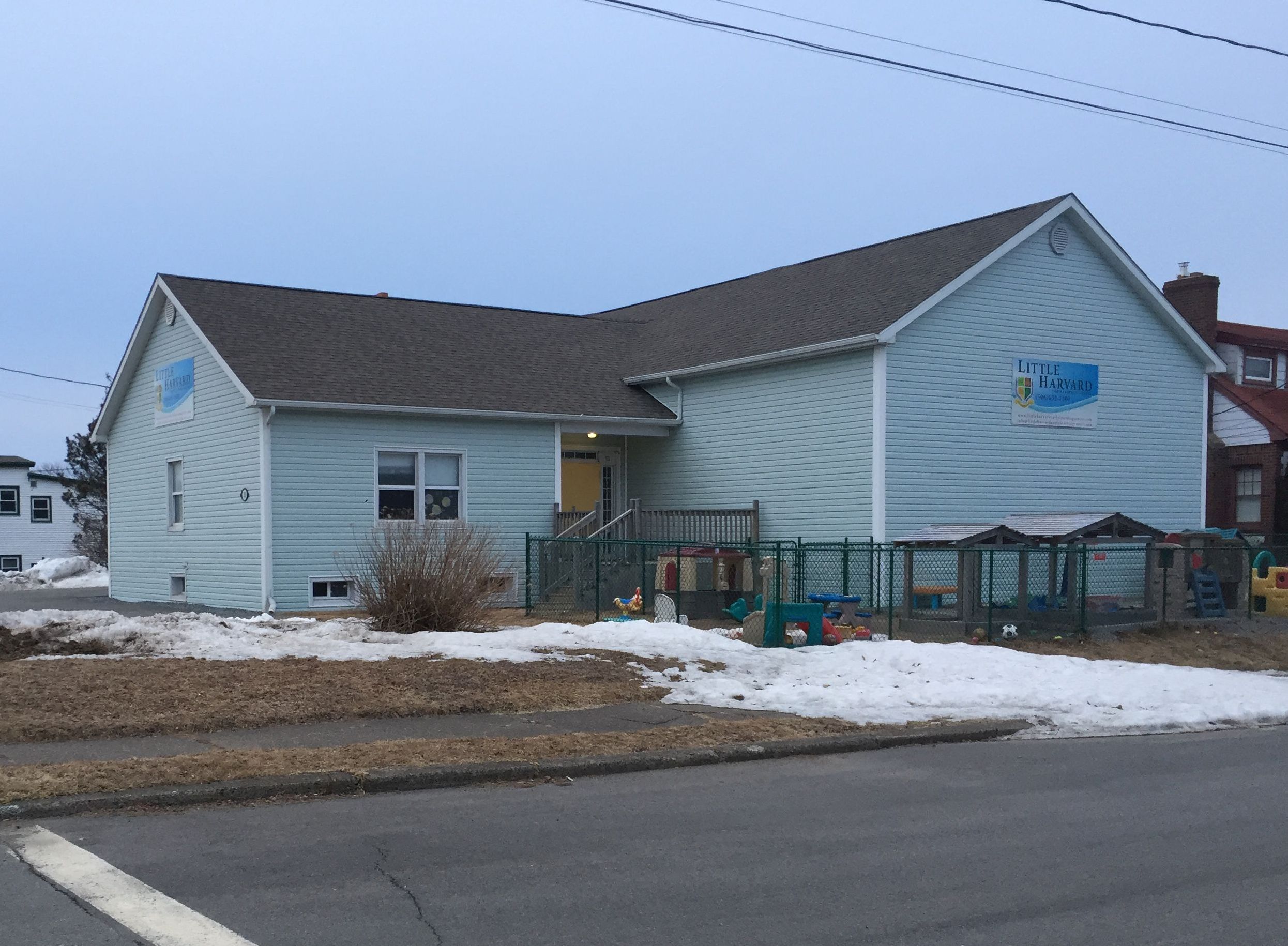 The Saint John, New Brunswick, meetinghouse, the first LDS meetinghouse in Atlantic Canada, served the Saints from its dedication in 1955 until 1980. It has since become a day care centre. This photo was taken in March 2017. The original building was white and had a steeple.[119] (Jake Cosman)
The Saint John, New Brunswick, meetinghouse, the first LDS meetinghouse in Atlantic Canada, served the Saints from its dedication in 1955 until 1980. It has since become a day care centre. This photo was taken in March 2017. The original building was white and had a steeple.[119] (Jake Cosman)
Newfoundland
The opening of Newfoundland for missionary work in 1948 was an historic event. In a letter dated 2 July 1948, the First Presidency informed S. Dilworth Young, president of the New England Mission, that Newfoundland was now included in his mission’s boundaries and that he should establish the Newfoundland District. Almost immediately, Young dispatched Elders Curtis Page and John M. Scowcroft to Halifax to apply for visas to enter Newfoundland, which was still an independent British dominion at the time. These were the first LDS missionaries ever assigned to Newfoundland.[120]
The missionaries endured a lengthy ferry ride from North Sydney, Nova Scotia, to Port aux Basques, Newfoundland, followed by a twenty-six-hour journey by train before finally arriving in St. John’s on 6 August. A week after their arrival they visited a newspaper office to ask about having notices printed and discovered that one of the printers, Walter Mullman, was a member of the Church. Mullman was surprised and delighted to see them and invited them to visit his family. Later that same month, they met another member, Wallace Smith of Ogden, Utah, who was stationed at the US military’s Pepperrell Air Force Base in St. John’s, and who sought them out when he learned they were in the area.[121]
On 6 July 1949, President S. Dilworth Young, president of the New England Mission, and Elder Milton R. Hunter of the First Council of the Seventy arrived in St. John’s. In addition to serving as the mission president, Young was also a member of the First Council of the Seventy, and this occasion marked the first time that General Authorities of the Church had visited Newfoundland.[122] The following day, they presided over a conference held in St. John’s Victoria Hall and officially organized the Newfoundland District.[123]
The six missionaries assigned to the district worked hard to help the Church grow. In the three months following the district’s creation, they visited 1,500 homes, distributed seventy copies of the Book of Mormon, and held street meetings on Saturday evenings.[124] They also continued to locate members of the Church around the island. In 1949 and 1950, they visited scattered members, including the Fred T. Wright family in Gander;[125] Zean R. Moore and Norman Lovedale at the Pepperrell Air Force Base in St. John’s;[126] eight individuals and two families at the Argentia naval base;[127] Archie B. Romney and his wife in Buchans;[128] and the Stanley Allen family in Harmon Field, near Stephenville.[129] All of these members had joined the Church elsewhere and then moved to Newfoundland, most of them for military duty.
The missionaries found the people of Newfoundland very hospitable but not particularly interested in the gospel. Elder John Scowcroft wrote that “those of St. John’s were really wonderful to us,” but their “friendliness overshadows interest” in the message.[130]
Finally, on 13 August 1950, two years and one week after the first missionaries arrived in Newfoundland, the elders baptized their first convert: a woman of Bay Roberts named Lavinia Webber Mercer.[131] In the years that followed, Mercer suffered from poor health and was unable to travel to St. John’s for Church meetings, but a missionary report written shortly after her death in 1963 (at age fifty-five) indicated that she had remained faithful to the gospel for the rest of her life.[132]
In February 1951, the first sister missionaries arrived in the province, followed later that month by two more elders. Four more missionaries arrived on 27 May, bringing the total in Newfoundland to fourteen. But two days later, seven were transferred off the island to other areas in the mission, and by December there were only two left.[133] The number of missionaries in Newfoundland fluctuated greatly over the next several years.
In January and March 1951 missionaries opened the areas of Grand Falls and Bonavista, respectively. On 11 March 1951, Sunday School was held for the first time in Newfoundland and conducted weekly thereafter at Victoria Hall in St. John’s.[134] On 10 August 1952, thirty-six people attended the Sunday School meeting, but the number in these years was usually around twenty-five. Although the group was small, they held social activities that sometimes managed to attract larger crowds. On 6 September 1952, for instance, fifty-five members and friends gathered at a park outside St. John’s for a treasure hunt, potluck, and campfire. The following month, on 31 October, around seventy-five people participated in a Halloween party.[135] Social events like these were extremely important for the Saints in Newfoundland and for groups throughout the rest of Atlantic Canada. They served not only as a missionary tool but also as a mechanism for instilling a greater sense of unity among the members.
Latter-day Saint military families from Canada and the United States posted to the Goose Bay Air Force Base in Labrador formed an air force group in 1954, holding regular church meetings in homes and later in the base chapel. John E. Carr, president of the New England Mission, flew to Goose Bay in 1961 and 1962 to meet with the Saints there. He encouraged the efforts of leaders to strengthen their youth and to prepare them to serve missions. Primary-age children of the Goose Bay group presented a Christmas program on Sunday, 24 December 1967, with forty-three people in attendance. In 1968, the group became the Goose Bay Servicemen’s Branch. When the base was closed in 1975, the branch was discontinued.[136]
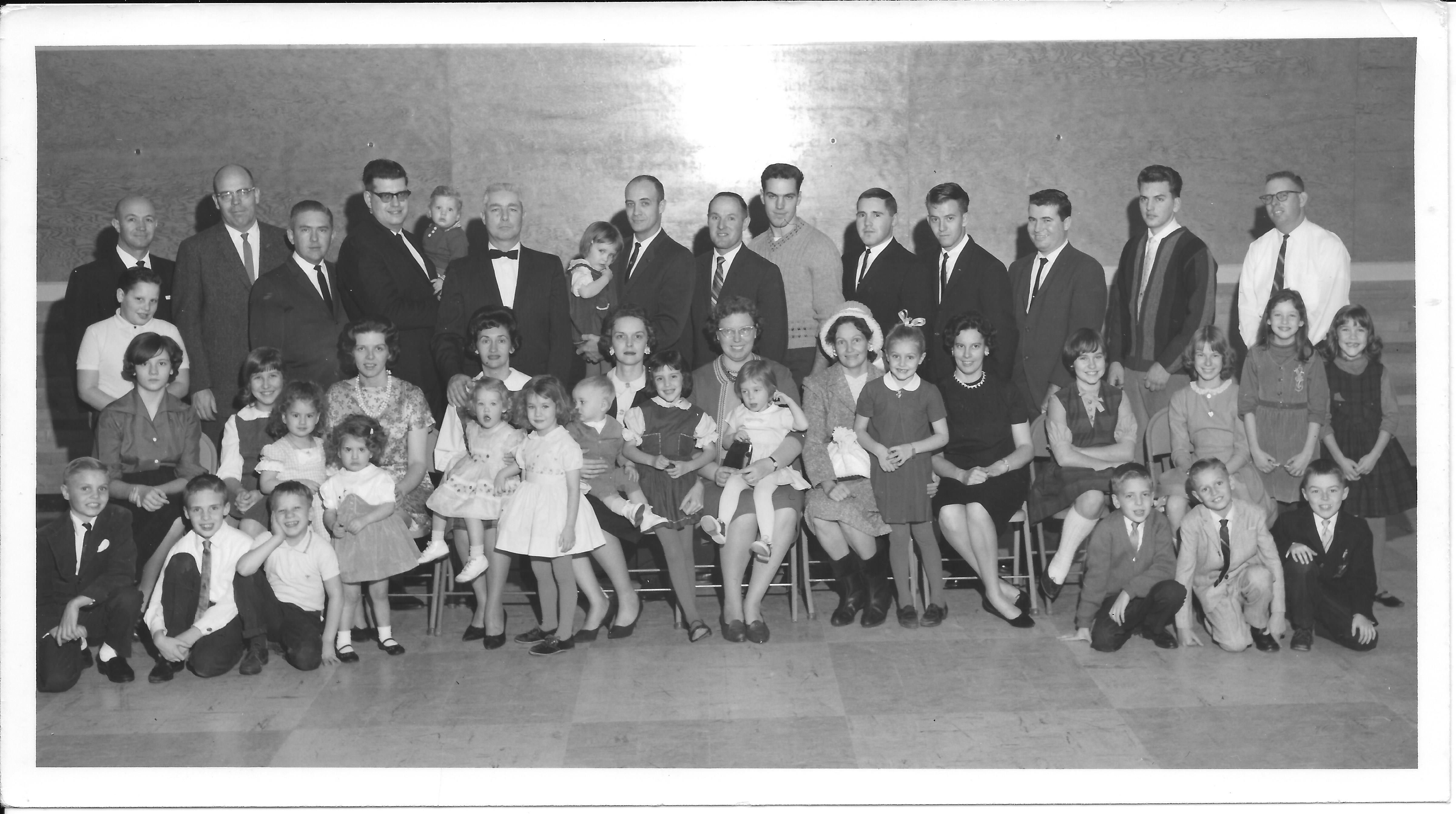 Goose Bay Air Force Group, Labrador, 1963. Military personnel and their wives and children formed a vigorous group until the air force base was closed in 1975. (Judith Harvey)
Goose Bay Air Force Group, Labrador, 1963. Military personnel and their wives and children formed a vigorous group until the air force base was closed in 1975. (Judith Harvey)
Two of the biggest challenges for the Church in Atlantic Canada in the 1950s and beyond were the transiency and isolation of the members. This was especially true in Newfoundland, where many members worked for the military and were not stationed for long in one place. The vast geography and sparse population also made it difficult to connect with other LDS people. In Newfoundland, the missionaries sometimes overcame the vast distances by travelling by military transport plane, which they did on 26 October 1954, when they flew from St. John’s to Harmon Air Force Base, located on the other side of the island, and on 15 December 1955, when they went to Goose Bay, Labrador.[137]
By February 1957, there were forty-seven members of the Church in St. John’s, enough to convince the mission president, Junius Jackson, to establish the first branch in the history of the Church in Newfoundland. Wilbur Q. Moses was called as the first branch president. He, his wife Gladys, and their two small children had moved from Nova Scotia to Newfoundland only a few weeks earlier.[138]
Prince Edward Island
Despite the flurry of missionary activity in the early war years, the Church in Prince Edward Island did not progress until the late 1950s. Missionaries who came in the summer of 1958 discovered that Marion Mitchell was the only member there, and that she stayed only during the summer months. The missionaries did, however, baptize Dwight Lemuel Llewellyn of Murray Harbour, PEI, on 4 September 1959.[139]
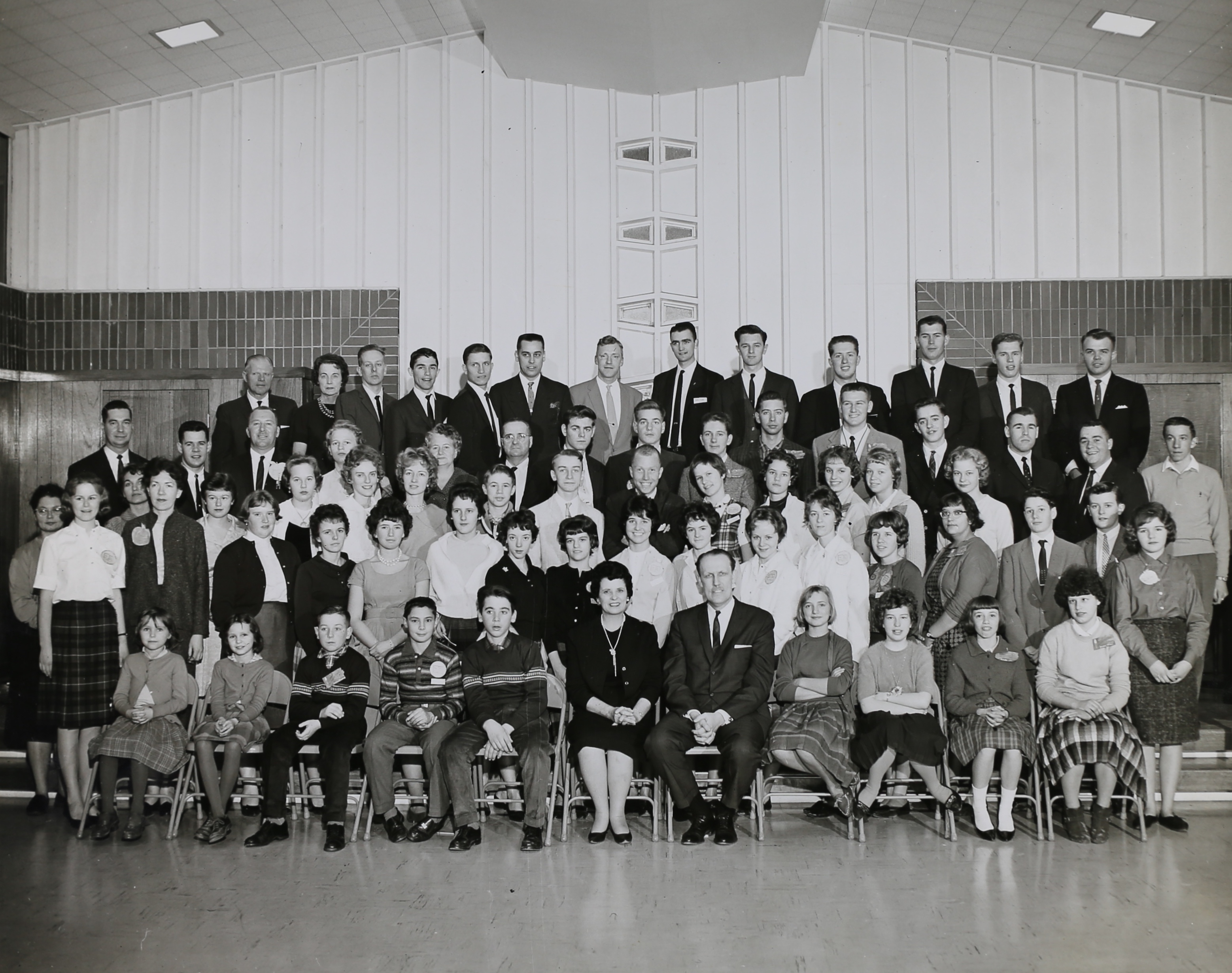 John E. Carr, president of the New England Mission, and his wife, May, are pictured here (centre front row), with members of the Maritime District gathered in Halifax for a conference in 1960. (Aubrey Fielden)
John E. Carr, president of the New England Mission, and his wife, May, are pictured here (centre front row), with members of the Maritime District gathered in Halifax for a conference in 1960. (Aubrey Fielden)
Developing Local Leadership, 1961–73
In the period from 1961 to 1973, the Church in Atlantic Canada not only grew in numbers but also developed local leaders, a sign of growing maturity. On 5 June 1961, John E. Carr, president of the New England Mission, created the Maritime District and called Walter Eugene Fellows as its president. A native of Salt Lake City, Fellows was living at the time in Lancaster (now part of Saint John), New Brunswick, working on assignment with Irving Oil Limited.[140] The district he was called to lead included all four Atlantic provinces and consisted of four branches: one in Nova Scotia (Halifax), two in New Brunswick (Saint John and Fredericton), and one in Newfoundland (St. John’s).[141] Three more branches were added in Nova Scotia a few days later: New Glasgow, Sydney, and Bridgewater, organized on 9, 10, and 11 June, respectively.[142]
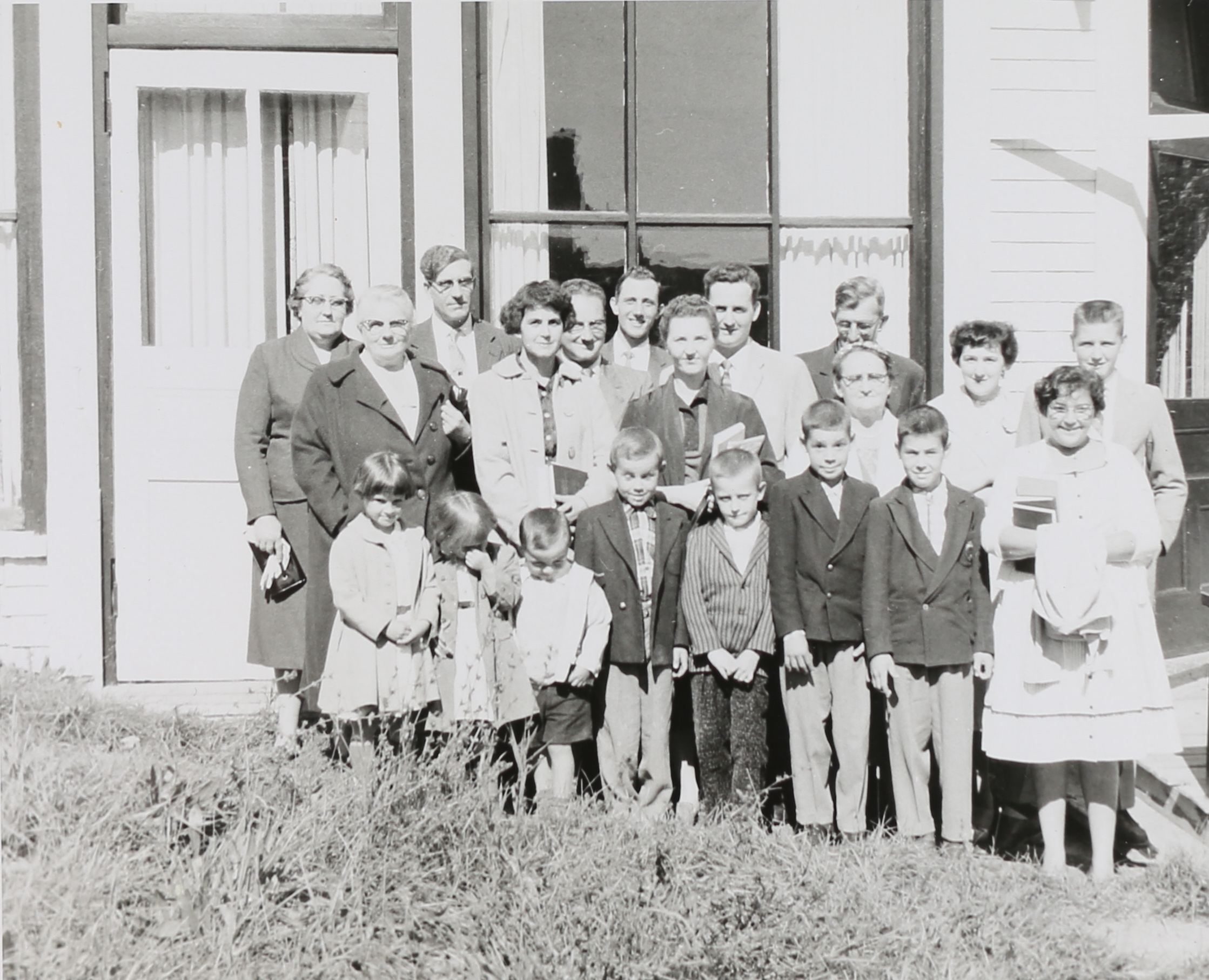 Members of the South Shore Sunday School in Bridgewater, Nova Scotia, on 20 September 1959. The Bridgewater Branch was formed two years later on 11 June 1961. (Aubrey Fielden)
Members of the South Shore Sunday School in Bridgewater, Nova Scotia, on 20 September 1959. The Bridgewater Branch was formed two years later on 11 June 1961. (Aubrey Fielden)
The vast size of the district posed immense challenges in terms of travel and communication for President Fellows and his two counselors, Lewis D. Robbins, a senior missionary based in Nova Scotia, and Roger F. Rawson, a missionary in Newfoundland. In fact, both the district and mission presidencies seriously considered dividing the district in two to help deal with these challenges, but in the end they decided not to do so because there were too few men available to fill priesthood leadership positions at both the district and branch levels.[143]
President Carr knew that the local members would have to learn to become effective leaders as an essential step to future growth in the area. “These folks will need a great deal of schooling in Church government and procedures,” he wrote in a letter to Robbins on 21 June 1961. “They need to be taught in all the rudiments of Church administration. They need to be shown how to conduct meetings properly and to give them the full sense of belonging to a Latter-day Saint organization.”[144] President Fellows likewise recognized the need for leadership development. “The major responsibility of the D.P. [district president] in Newfoundland will [be] one of training these brethren in leadership techniques,” he wrote, while visiting Newfoundland in July 1961.[145]
On 10 December 1961, another branch was added in Nova Scotia, this time in Kentville. As was often the case at this time, the person appointed to lead the new unit was not from the area. In this instance, a senior missionary from Utah, Frank D. Coombs, was given the responsibility of presiding over the branch and teaching the local members leadership skills.[146]
After serving as district president for only a year, President Fellows received a job transfer and returned to the United States in June 1962.[147] In January 1963, Aubrey A. Fielden, a native Nova Scotian and resident of Dartmouth, replaced him as district president and stayed in that position until 1969, rendering remarkable service over a period of six years.[148]
Growth across the Atlantic Provinces
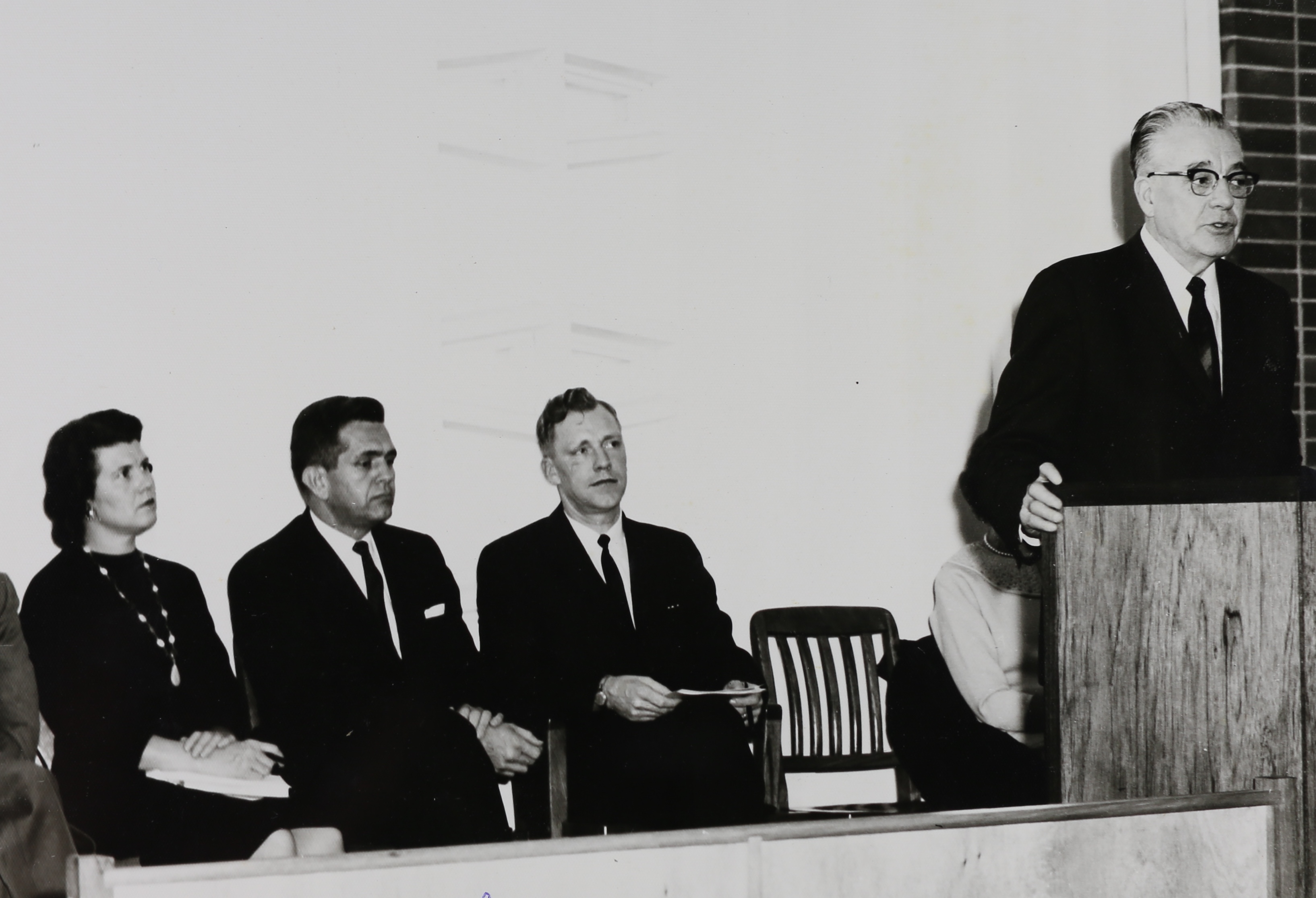 Harold B. Lee of the Quorum of the Twelve, speaking in 1967 to members of the Maritime District. Also pictured, left to right: Donna Packer, Boyd K. Packer (president of the New England Mission), and Aubrey Fielden (president of the Maritime District). (Aubrey Fielden)
Harold B. Lee of the Quorum of the Twelve, speaking in 1967 to members of the Maritime District. Also pictured, left to right: Donna Packer, Boyd K. Packer (president of the New England Mission), and Aubrey Fielden (president of the Maritime District). (Aubrey Fielden)
In 1964, Ralph and Gerda Waugh moved from New York State to Prince Edward Island. Although they had investigated for several years and had their son Kevin blessed in the Church, they had only recently (29 November 1963) been baptized. They moved to PEI because they felt inspired to return to the province where Ralph had been born. In doing so, they went to a place where the Church had no missionaries, no units, and no real presence, which would have been challenging for anyone, but especially for brand-new members. However, their faith did not falter, and in time they located another member, Kay Callaghan, and started meeting with her on Sundays to discuss the scriptures. In 1966, they invited Boyd K. Packer, then president of the New England Mission, to visit them, and in early July, President Packer and his wife, Donna, visited the island. While there, Packer promised to assign missionaries to the province and quickly made good on that promise by sending two missionaries there two weeks later.[152] The Waughs held many leadership positions for years and were great pioneers of the Church in PEI. In 2008, Ralph Waugh passed away at the age of eighty-three.[153]
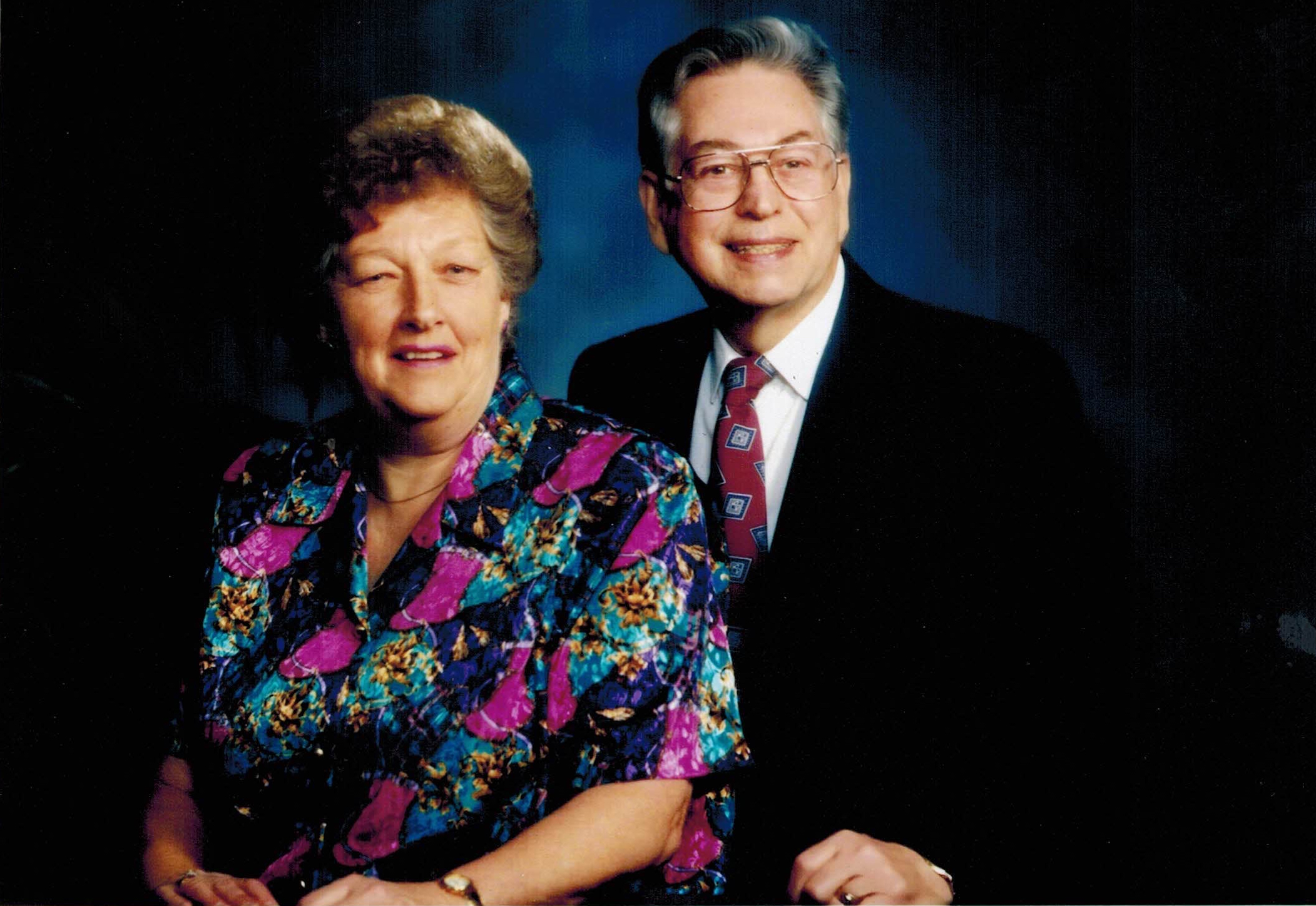 Ralph and Gerda Waugh were Church pioneers on Prince Edward Island. Moving there in 1964 as recent converts, they began a home Sunday School in 1966, and Ralph Waugh was called as the first branch president in 1969. (Kevin Waugh)
Ralph and Gerda Waugh were Church pioneers on Prince Edward Island. Moving there in 1964 as recent converts, they began a home Sunday School in 1966, and Ralph Waugh was called as the first branch president in 1969. (Kevin Waugh)
The Church in Newfoundland got a boost in 1965 when Thomas P. Bolton was baptized on 7 March at the Kinsmen Pool in St. John’s. Bolton was originally from England, where he had worked as an architect before moving to Newfoundland in 1962 to work for the provincial government as deputy director of urban and rural planning. Later, he opened his own architectural practice in St. John’s. Although Bolton did not stay long in Newfoundland—he and his family moved to Utah in December 1969—he managed to contribute a great deal to the Church in Newfoundland while he was there. Shortly after his baptism, he began writing a weekly religious column for the local newspaper, the Daily News, titled “The Church of Jesus Christ of Latter-day Saints Speaks,” which continued for two years. He also mailed copies of the Book of Mormon and letters testifying of the book’s truthfulness to friends and to political, religious, and community leaders. In a two-year period he mailed 1,200 copies.[154] He was also instrumental in helping the St. John’s Branch obtain a site for a meetinghouse, and he designed the building and oversaw the construction process in 1969.
On 17 January 1965, the Saint John and Fredericton Branches were transferred to the Northern Maine District so that members would not have to travel as far—Bangor as opposed to Halifax—to attend district meetings.[155] This change did not last long, however, as the New Brunswick District was formed only two years later (on or before 16 July 1967),[156] which was composed of the Saint John and Fredericton Branches and the newly created Moncton Branch (established on 3 July 1966),[157] as well as Church members on Prince Edward Island.
Branches were also established in Truro, Nova Scotia, on 2 June 1966;[158] Goose Bay, Labrador, on 1 September 1968;[159] Summerside, PEI, on 21 December 1969 (with Ralph Waugh as president);[160] and Dartmouth, Nova Scotia, on 1 April 1973.[161]
During this period, United States military bases in Newfoundland played a significant role. An LDS servicemen’s group at Harmon Air Force Base near Stephenville, Newfoundland, was organized in 1950 and functioned until the base closed in 1966. Prior to the organization of the St. John’s Branch in 1957, Church members in St. John’s attended the Pepperrell Group. Latter-day Saint servicemen often provided leadership to the Saints in St. John’s until the base closure in 1960.[162] The branch in Goose Bay, Labrador, was formed in 1968 from the Goose Bay Air Force Group, which had been functioning for some time on the military base, and continued until the base closure in 1975.
Meetinghouses were dedicated in Bridgewater, NS, in 1967[163] and in Fredericton, NB, in 1968,[164] and the St. John’s Branch moved into its first-phase meetinghouse in December 1969.[165] Despite various setbacks, slowly but surely, the Church was growing in Atlantic Canada.
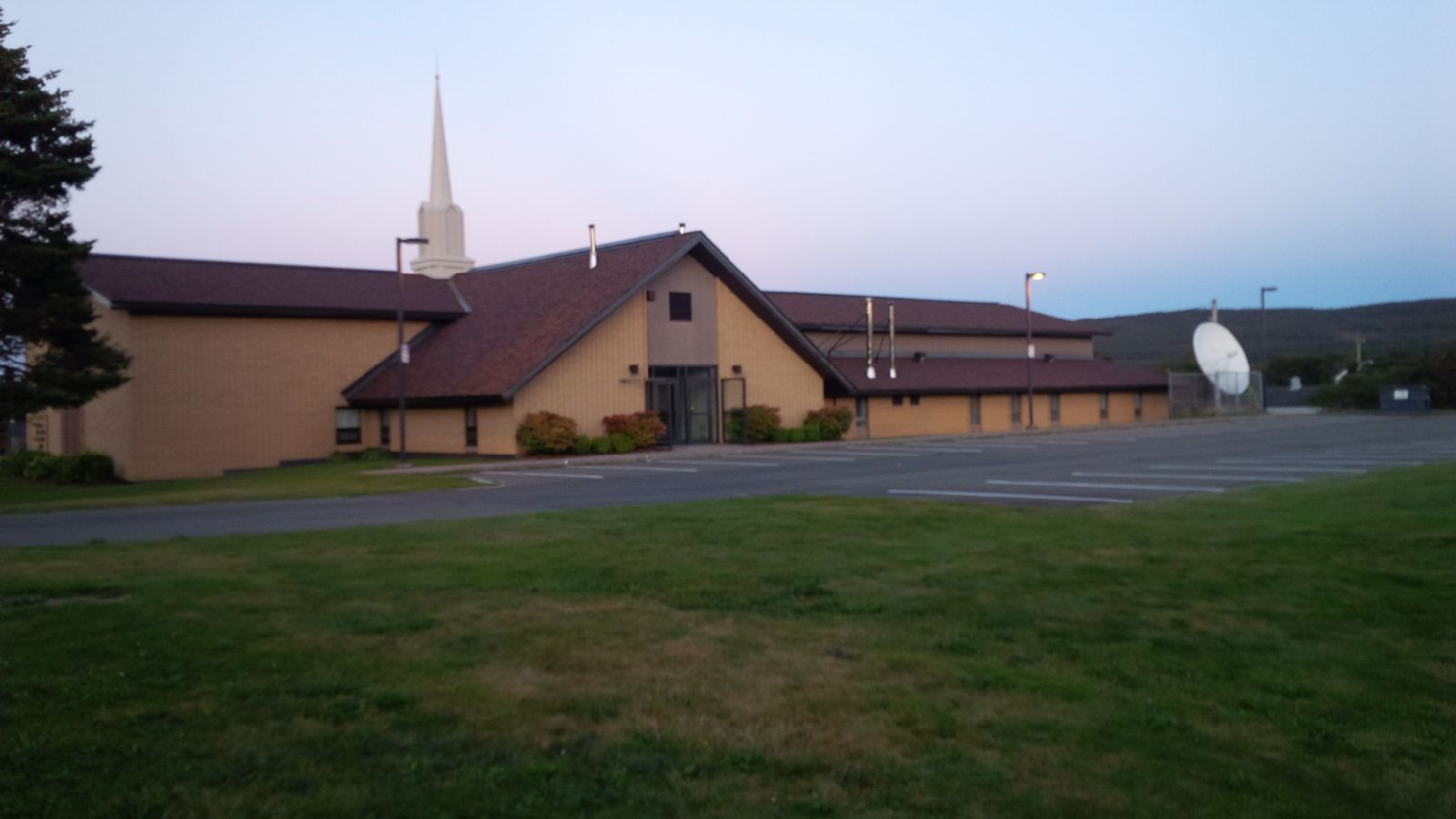 The St. John’s first phase building, which was completed in 1969, has since been enlarged to become a multiphase meetinghouse, equipped with a satellite dish. (Mandy Harline)
The St. John’s first phase building, which was completed in 1969, has since been enlarged to become a multiphase meetinghouse, equipped with a satellite dish. (Mandy Harline)
Significant Growth and Development, 1973–93
On 1 July 1973, the Canada Maritimes Mission—renamed the Canada Halifax Mission the following year—was created to oversee missionary work in Nova Scotia, New Brunswick, Prince Edward Island, Newfoundland, and part of northern Maine.[166] This was a major development in the history of missionary work in Atlantic Canada, as this was the first time a mission had been created to focus all of its resources on the region. With headquarters in Dartmouth, Nova Scotia, this was also the first time a mission president was stationed inside Atlantic Canada.
The creation of the Canada Halifax Mission marked the beginning of a period of significant growth and development for the Church in the region. Over the next twenty years, membership numbers increased dramatically, many branches and wards were established, and two stakes were formed.
In 1973, there were 1,169 members of the Church in Nova Scotia, 513 in New Brunswick, 290 in Newfoundland, and 100 in Prince Edward Island, which equalled 2,072 across the four provinces. By 1993, twenty years later, the numbers had risen to 3,989 in Nova Scotia, 2,123 in New Brunswick, 556 in Newfoundland, and 346 in Prince Edward Island for a total of 7,014.[167] Over that twenty-year period, membership increased by 4,942 people, making this by far the greatest period of growth in the history of the Church in Atlantic Canada.
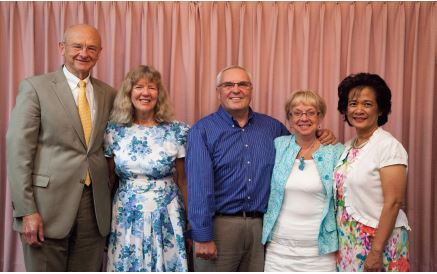 The Church in Atlantic Canada experienced its greatest period of growth between 1973 and 1993. Roy and Hilda Fox, Lloyd and Cynthia Hart, and Michael and Sandra Choo (shown here, left to right, Michael Choo not in photo) are among the strong families who were baptized in the Halifax-Dartmouth area during that period. The Foxes later served as president and matron of the Halifax Temple. (Arnon Livingstone)
The Church in Atlantic Canada experienced its greatest period of growth between 1973 and 1993. Roy and Hilda Fox, Lloyd and Cynthia Hart, and Michael and Sandra Choo (shown here, left to right, Michael Choo not in photo) are among the strong families who were baptized in the Halifax-Dartmouth area during that period. The Foxes later served as president and matron of the Halifax Temple. (Arnon Livingstone)
The worldwide Church experienced one of the greatest periods of its growth in these years as well, going from 3.3 million total members in 1973[168] to 8.7 million in 1993.[169] However, the average annual growth rate was actually higher in Atlantic Canada during this period than it was for the Church as a whole: 6.3 percent for Atlantic Canada compared with 4.9 percent worldwide.
New Meetinghouses
In 1973, most units were still very small, and many had to rent meeting spaces that were less than ideal. When, for example, members in the St. Stephen, NB, area gathered on 17 December 1975 to organize the St. Croix Branch (renamed the St. Stephen Branch in 1983), they met in a room at the top of an old building that had a broken window that let in the rain.[170] The Summerside Branch in Prince Edward Island met at various places over the years, including the Orange Hall, the YMCA, the Knights of Columbus, and some schools before they obtained a building of their own in 1983.[171] This was typical for most units in Atlantic Canada at this time. Members spent a lot of time and effort raising funds to pay for proper LDS meetinghouses to call their own.
Unlike today, local units then had to raise a significant portion of the money for new meetinghouses in addition to what their members paid in tithing. The St. John’s Branch, in 1975, undertook a number of projects to raise funds for an expansion of their first-phase meetinghouse,[172] including a car wash, which brought in $107; a concession stand at the annual St. John’s Regatta, which raised $627.87; and a sale of handmade items at the Avalon Mall, which contributed $900 to the building fund.[173] Other units engaged in very similar fundraising activities throughout these years.
Every time a unit reached its goal of acquiring a meetinghouse, the members were filled with excitement and gratitude. At the groundbreaking ceremony for the Kentville Branch meetinghouse on 3 August 1976, Albert Schofield said, “Having our own chapel has long been a dream of mine, and through its use we can be much better representatives of our Heavenly Father.” Schofield, like other branch members, had worked tirelessly over the years to raise funds and had cleared the land where the meetinghouse was to stand.[174]
Seminary and Institute
Seminary in Atlantic Canada received a boost in 1978, when Allen Litchfield arrived as the first Church Education System director. Terry Livingstone, when he came to Nova Scotia as CES director in 1982, indicated that seminary and institute were already established in the larger centres and home study seminary in New Brunswick. By the time Livingstone left the area in 1991, early morning and home study seminary were well established in multiple locations (including Dartmouth, Cole Harbour, Halifax, Bridgewater, Kentville, Saint John, and Fredericton), and institute classes were being held in Halifax, Wolfville, Fredericton, and Saint John. Livingstone expressed delight that when he visited Atlantic Canada in 2014, many Church leaders in the area were his former students.[175]
The Washington DC Temple
A significant building for all the members in Atlantic Canada, the Washington DC Temple, was completed and dedicated in November 1974. This made it much easier for the Atlantic Saints to attend a temple. Washington, DC is a 1,750 km (1,087 miles) car ride from Halifax, NS, which is still a great distance, but it is considerably closer than travelling 4,841 km (3,008 miles) to Salt Lake City or 5,100 km (3,169 miles) to Cardston, Alberta, which were the closest temples before the one in Washington, DC.[176] Many individuals, families, and youth groups from Atlantic Canada visited the Washington D.C. Temple, which remained the area’s assigned temple until the Toronto temple opened in 1990.
 Greg and Sandra Ross, baptized in Kentville, NS in 1976, took their family to be sealed in the Washington D.C. Temple in 1977. (Sandra Ross)
Greg and Sandra Ross, baptized in Kentville, NS in 1976, took their family to be sealed in the Washington D.C. Temple in 1977. (Sandra Ross)
The Multiplication of New Branches
Thirteen new branches were organized between 1976 and 1983, starting with Yarmouth (NS) on 17 October 1976;[177] followed by Corner Brook (NF), 19 March 1978;[178] Woodstock (NB) and Perth-Andover (NB), 24 June 1980;[179] Bathurst (NB), 27 July 1980;[180] Gander (NF), 1 June 1981;[181] Montague (PEI), 5 July 1981;[182] Richibucto (NB), 10 October 1981; Argentia (NF), 12 June 1983; Greenwood (NS) and Windsor (NS), 17 January 1983; Sussex (NB), 27 March 1983; and Annapolis Royal (NS), 29 September 1983.[183]
The Bathurst Branch in northeastern New Brunswick was the first French-speaking branch in the province. The Gander Branch served a growing population connected with the Gander airport, a vital refueling link at that time in trans-Atlantic air travel. The Argentia, Perth-Andover, and Richibucto Branches did not last long, and the Montague, Windsor, and Sussex Branches had to close for a time before reopening, but the creation of thirteen branches in eight years is a clear indication that the Church was growing at a significant rate.
New Districts and District Realignments
Rapid Church growth meant that new districts were also created, and boundaries were readjusted several times after 1978, prior to the organization of the two stakes in the mid to late 1980s. On 30 July 1978, the Newfoundland District was created by separating Newfoundland from the Maritime District. Calvin Hodder served as president of this new district,[184] which was renamed the St. John’s Newfoundland District in 1984. (After the district was dissolved in 1989, unit leaders in the province reported directly to the Canada Halifax Mission president.[185] )
The process of dividing districts to create new ones continued in 1980. On 30 March, part of the Maritime District was taken to create the Nova Scotia South District, which was led by David Evans and consisted of the Bridgewater, Kentville, and Yarmouth branches.[186] Eleven days later, on 11 April, the remaining part of the Maritime District became the Nova Scotia North District, with Allen Litchfield as president and with headquarters in Halifax.[187] Two days after that, on 13 April, the Charlottetown Prince Edward Island District was born out of a division of the New Brunswick District. Michael Shumate served as the first president of the Charlottetown PEI District. [188] (In 1987, the Charlottetown District was discontinued and the PEI units were reunited with the New Brunswick District.[189] )
On 10 October 1983, new realignments again took place at a joint conference of the Nova Scotia South and Nova Scotia North Districts. Ray Hassell, president of the Canada Halifax Mission, announced that the two districts would be dissolved and that three new districts would take their place: the Yarmouth Nova Scotia District, led by Thomas Moses, with the Yarmouth, Liverpool, and Annapolis Royal Branches; the Sydney Nova Scotia District, led by Stanley Hodder, with the Sydney, North Sydney, New Glasgow, and Port Hawksbury Branches; and the Halifax Nova Scotia District, led by Richard Moses, with the Halifax, Dartmouth, Bridgewater, Kentville, Greenwood, Windsor, Truro, Parrsboro, and Amherst Branches. Seven hundred eighty-seven people attended the conference.[190]
The Dartmouth Nova Scotia Stake
The three new Nova Scotia districts operated for two years before a much bigger change came about on 12 May 1985. On this date, Neal A. Maxwell of the Quorum of the Twelve organized the Dartmouth Nova Scotia Stake. The stake replaced the three Nova Scotia districts and took in all of the same area that they had covered. Terry Livingstone, a Church Educational System employee, was sustained as stake president, with Richard Moses and David Evans as counselors. Stanley Hodder was also ordained at the conference as the first patriarch.[191]
The organization of the Dartmouth Nova Scotia Stake was an event of major importance. The members in Nova Scotia had been working towards the goal of stakehood for years—in 1978, for example, the theme of the Maritime District had been “Becoming a Stake in ’78.”[192] The fact that a stake was now established was a sign that the Church in this area had become strong and mature.
Many positive things happened in the years immediately following the stake’s creation. On 12 February 1986, Gordon B. Hinckley, then serving as first counselor in the First Presidency, called the mission president, David E. Sorensen, to congratulate him on “the success the mission had been seeing in the last few months.” A few months later, on 4 May, Derek A. Cuthbert of the First Quorum of the Seventy noted while speaking at stake conference in Dartmouth that “the Canada Halifax Mission has shown more progress in the past year than any mission in the North American Northeast Area.” In October of that same year, there were fifty-four baptisms in the mission, which set a new record for the number of baptisms achieved by the mission in one month.[193]
In 1986, the Dartmouth Nova Scotia Stake Centre was completed, which was the largest LDS meetinghouse in Atlantic Canada to that point. In March, several dignitaries attended an open house, including then-Dartmouth mayor and future provincial premier John Savage. Verla Sorensen expressed what was surely the opinion of many people when she said that the building was “a major step forward in improving the image of the Church in Dartmouth.”[194]
The Dartmouth Ward had grown so much that by the fall of 1986, it was necessary to divide the ward, creating the Cole Harbour Ward on 30 November.[195] Both wards were housed in the stake centre, which created an interesting situation in the early 1990s when the bishops of the two wards were father and son—Wilbur Moses of the Dartmouth Ward and his son Richard Moses of the Cole Harbour Ward. An article published in the Church News on 27 February 1993 noted, “Members of the Dartmouth or Cole Harbour wards . . . don’t just hear double—they see double—when someone calls out for Bishop Moses and two men answer.”[196]
The ward in Halifax also experienced so much growth in these years that it too had to be divided, creating the Sackville Ward on 23 October 1988. Gilbert Smith, a grandson of Nelson and Edna Smith who had joined the Church in Windsor in 1932, was called as the first bishop of the newly formed ward.[197] Later, in 2000, he replaced Stephen Maxwell as president of the Dartmouth Nova Scotia Stake and served in that position until 2009, when he was replaced by David Evans.[198]
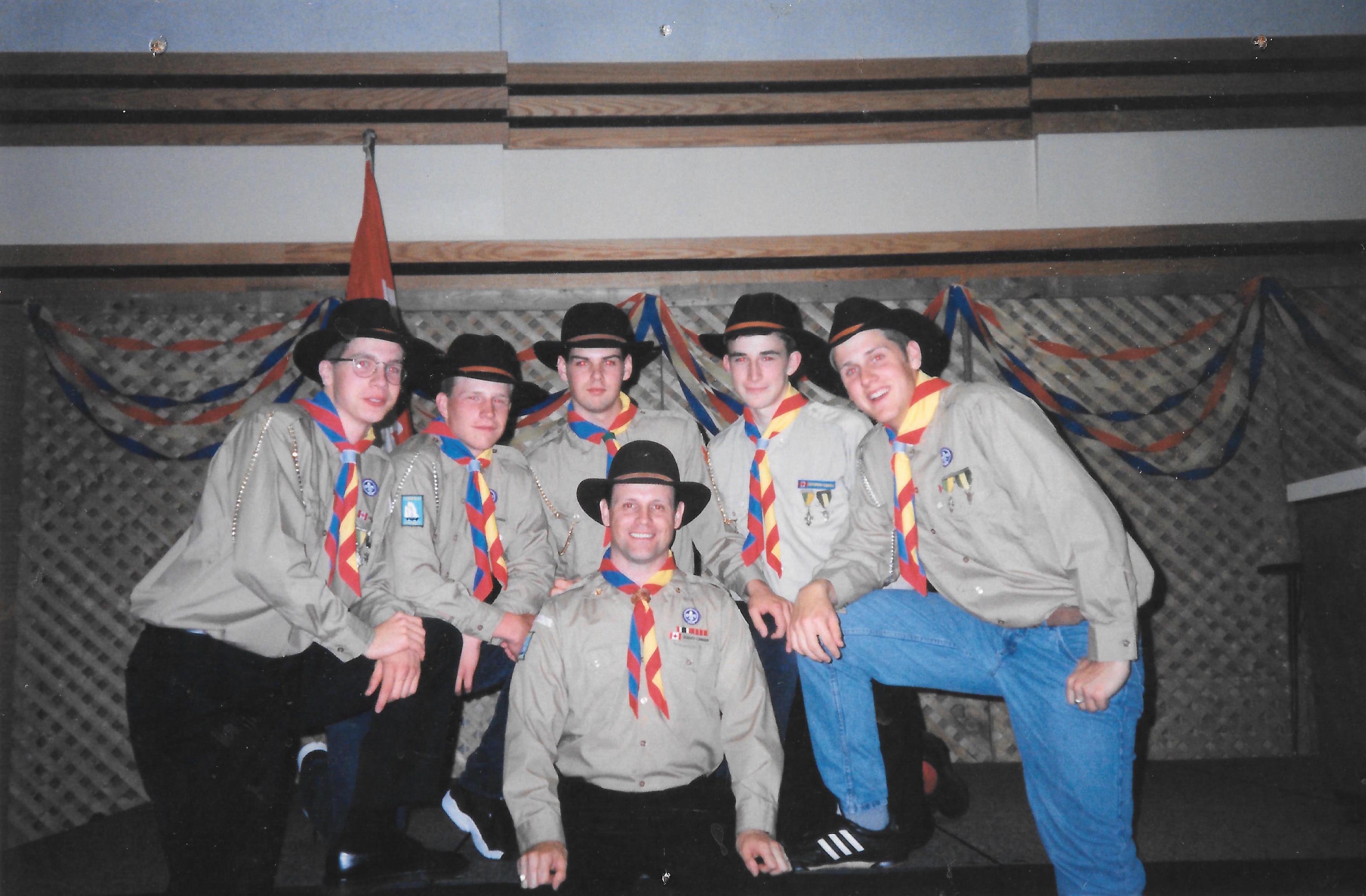 Recipients of the Duke of Edinburgh Gold Award from the Bridgewater Ward, 1995. Back row, left to right: Aden Hirtle, Justin Wentzell, Kent Wentzell, J. R. Lyon, Patrick Hunt; front row, Robert Lyon. Though the Scouting program was not fully implemented in the Church in Atlantic Canada, this group of LDS Scouts qualified for an additional non-Scouting award, which was based on service, skills development, physical fitness, an adventurous journey, and a residential project. (Diane Wentzell)
Recipients of the Duke of Edinburgh Gold Award from the Bridgewater Ward, 1995. Back row, left to right: Aden Hirtle, Justin Wentzell, Kent Wentzell, J. R. Lyon, Patrick Hunt; front row, Robert Lyon. Though the Scouting program was not fully implemented in the Church in Atlantic Canada, this group of LDS Scouts qualified for an additional non-Scouting award, which was based on service, skills development, physical fitness, an adventurous journey, and a residential project. (Diane Wentzell)
The Saint John New Brunswick Stake
In New Brunswick, Church growth resulted in the creation of the Newcastle Branch on 15 April 1987 and of the Kennebecasis Branch on 1 November 1987, which came about as a result of a division of the Saint John Branch.[199] The growth of the Church in New Brunswick was so encouraging that on 6 November 1987, the president of the North American Northeast Area, John Carmack, invited the mission president, David Sorensen, to submit an application to create a stake in New Brunswick and Prince Edward Island. On 17 June 1988, Howard W. Hunter, then President of the Quorum of the Twelve, informed President Sorensen that the application had been approved.[200]
On Friday, 24 June 1988, Joseph B. Wirthlin of the Quorum of the Twelve arrived in Saint John, accompanied by Malcolm Warner, the regional representative. The next day they met with priesthood leaders and conducted interviews before addressing 625 members at the Saturday evening conference session. The following morning, 26 June, Elder Wirthlin formally created the Saint John New Brunswick Stake and presented Blaine Hatt as the first stake president, with Reginald Hilchie and Todd Christiansen as his counselors.[201] The stake included all of New Brunswick and Prince Edward Island, plus Cumberland County in Nova Scotia, and much of northern Maine. Approximately 750 people attended this historic conference. Harry Spragg was called on 16 April 1989 to serve as the stake’s first patriarch.[202]
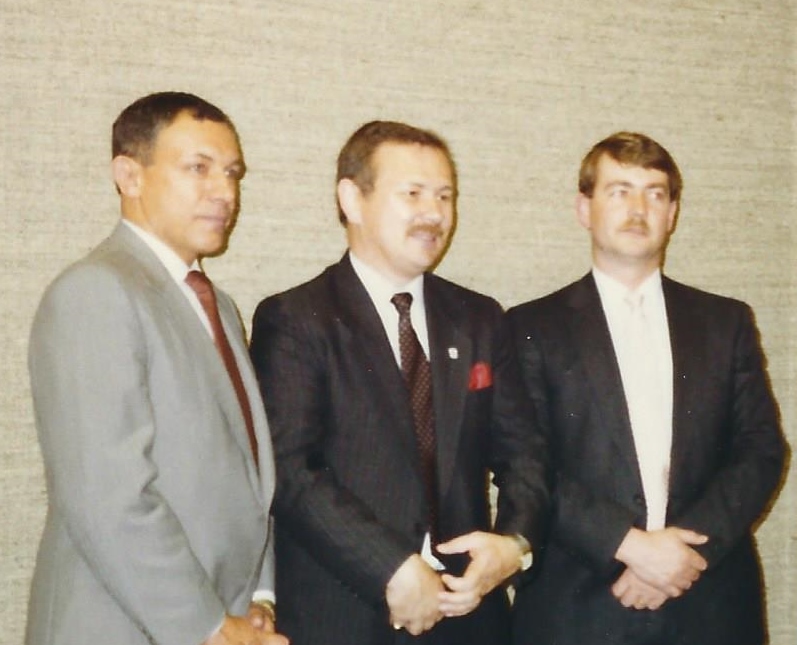 First stake presidency of the Saint John New Brunswick Stake 1988. Left to right: Reg Hilchie, first counselor; President Blaine Hatt; Todd Christiansen, second counselor. (Debbie Christiansen)
First stake presidency of the Saint John New Brunswick Stake 1988. Left to right: Reg Hilchie, first counselor; President Blaine Hatt; Todd Christiansen, second counselor. (Debbie Christiansen)
Another result of the Church’s growth in Atlantic Canada was the establishment of the New Glasgow District on 5 September 1989. The district was created by taking the northern part of Nova Scotia from the Dartmouth Nova Scotia Stake as well as Prince Edward Island and Cumberland County, Nova Scotia, from the Saint John New Brunswick Stake.[203]
The missionaries were of course a major reason for the significant growth of the Church in Atlantic Canada between 1973 and 1993, but the success was also due to the work and leadership of the local members, and to the fact that so many capable people joined the Church and contributed to it during this period. In the past, a few key families and individuals had played major roles. Now they were joined by many more people who also made great contributions and who brought new life and energy to the Church in the region.
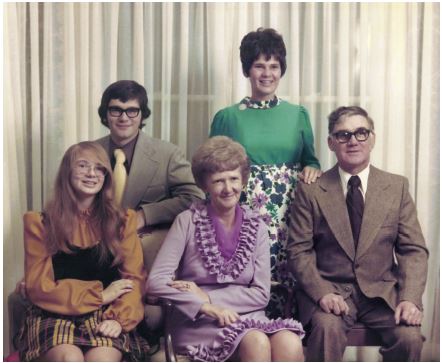 Harry and Lavinia Spragg, shown here in 1973, were baptized in Saint John in 1965, along with their oldest daughter Carol (standing) and son David (second from left). Their youngest daughter Bonnie was baptized in 1967. The family has contributed much to the growth of the Church over many years. Harry was patriarch of the Saint John New Brunswick Stake, and David became president of that stake in 2012. (Carol Spragg Crilley)
Harry and Lavinia Spragg, shown here in 1973, were baptized in Saint John in 1965, along with their oldest daughter Carol (standing) and son David (second from left). Their youngest daughter Bonnie was baptized in 1967. The family has contributed much to the growth of the Church over many years. Harry was patriarch of the Saint John New Brunswick Stake, and David became president of that stake in 2012. (Carol Spragg Crilley)
Most of the new leaders were people who had become converted in the 1970s and 1980s. Verla Sorensen recorded in 1987: “After visiting the Dartmouth and Halifax Wards today, we are deeply impressed by the quality of the converts as well as the quantity. For example, during a Relief Society lesson in Dartmouth Ward, the teacher asked how many in attendance had been born in the Church. Only two sisters raised their hands. The same could be said of most of the units in the mission. Almost all of the adult membership and leadership of the Church are converts, having joined the Church within the last few years.”[207]
Steps Forward and Steps Back, 1994–2015
The Church in Atlantic Canada continued to take significant steps forward between 1994 and 2015.
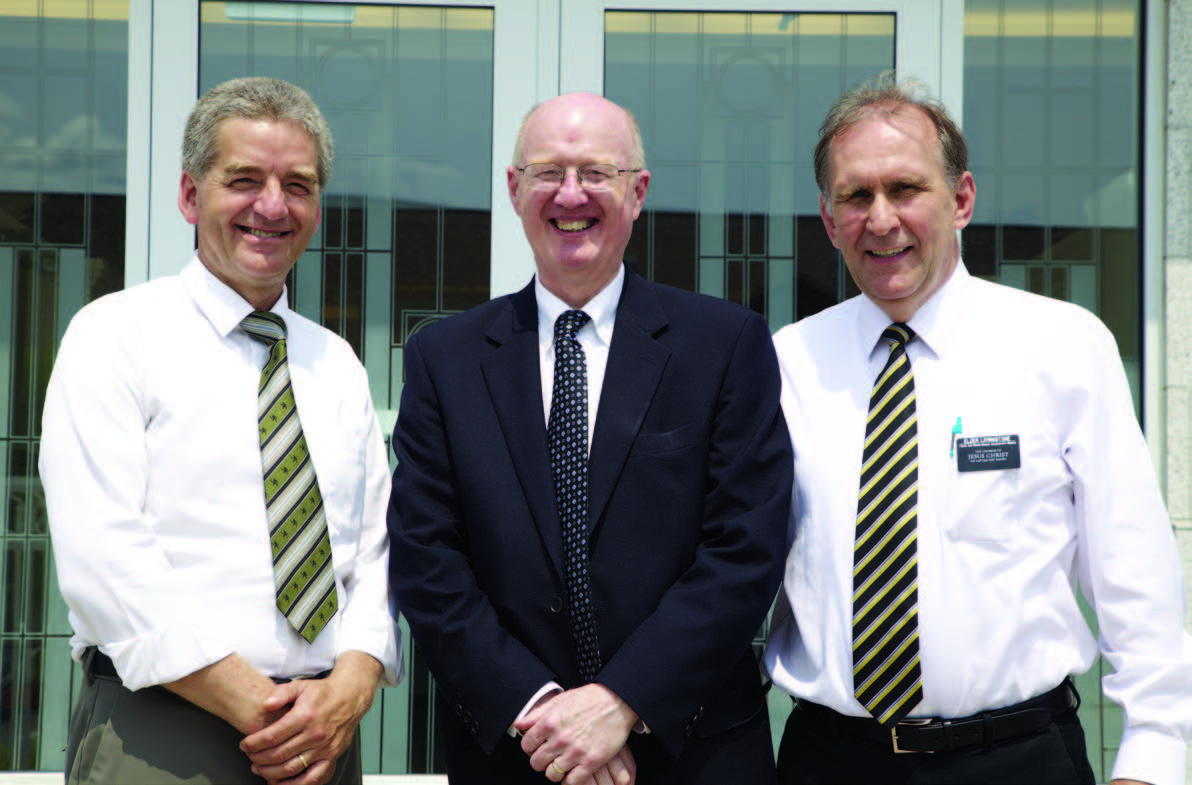 This photo, taken in front of the Halifax Nova Scotia Temple in 2014, shows three of the four men who had served as president of the Dartmouth Nova Scotia Stake. Left to right: Gilbert Smith (2000–2009), David Evans (2009–present), and Terry Livingstone (1985–91). Stephen Maxwell, not shown, served from 1991 to 2000. (Arnon Livingstone)
This photo, taken in front of the Halifax Nova Scotia Temple in 2014, shows three of the four men who had served as president of the Dartmouth Nova Scotia Stake. Left to right: Gilbert Smith (2000–2009), David Evans (2009–present), and Terry Livingstone (1985–91). Stephen Maxwell, not shown, served from 1991 to 2000. (Arnon Livingstone)
The Halifax Nova Scotia Temple
At the October 1997 general conference, Gordon B. Hinckley, President of the Church, made an historic announcement that the Church would begin constructing small temples in areas where members had to travel great distances to reach the nearest temple. At that time, there were only fifty temples operating throughout the world,[208] and the nearest one to members in Atlantic Canada was in Toronto, which was about 2,000 kilometres (1,243 miles) from Halifax by car.
Within twenty-four hours of hearing this exciting announcement, Stephen Maxwell, president of the Dartmouth Nova Scotia Stake, drafted a letter to the First Presidency asking them to consider building a small temple in Nova Scotia. He also called the president of the Saint John New Brunswick Stake, Blaine Hatt, to let him know that he would be submitting a request for a temple and discovered that President Hatt intended to submit a request as well.[209]
A few months after sending his letter, President Maxwell learned that President Hinckley was planning a visit to Halifax and intended to speak to the members while he was there. On 12 February 1998, President Hinckley, accompanied by Jeffrey R. Holland of the Quorum of the Twelve, came to the World Trade and Convention Centre in Halifax, where they addressed about 2,000 Saints who were thrilled to see and hear their prophet. President Maxwell later reported the following to the Church News: “From the time we learned they were coming, the stake has been electrified with excitement; that Spirit permeated everyone.”[210] Although many of those attending that meeting had hoped that President Hinckley would announce a temple for the area, no such announcement was made that night. But on Thursday, 7 May 1998, the First Presidency announced that there would be a temple in Halifax. The joyful news spread rapidly. By the time the official letter from the First Presidency was read in sacrament meetings the next Sunday, there were few members who had not already heard the news.[211]
Interestingly, President Maxwell and his counselors had accidentally learned prior to 7 May that there would be a temple in Halifax. During a stake presidency meeting, Maxwell received an unexpected phone call from someone at the Church’s architectural department who wanted to know if the Halifax temple would need a mudroom. Apparently, this person did not realize that President Maxwell had not yet been informed that a temple was being planned. The stake presidency was directed to keep the secret until after the official announcement was made. Fortunately, they did not have to wait too long for the official announcement to follow.[212]
When President Maxwell sent his application to the First Presidency, he suggested the vacant land adjacent to the stake centre as a possible location for the temple, and this is precisely where it was later constructed. To his knowledge, no other site was ever seriously considered.[213] During his term as the first stake president of the Dartmouth Nova Scotia Stake (1985–91), Terry Livingstone had resisted the sale of this surplus property with the idea that someday a temple would be built there.[214]
The groundbreaking ceremony was held on 12 October 1998 and construction teams began work on 9 November. Less than one year later, the temple was completed,[215] and an open house, which attracted more than 8,100 people, was held 4–7 November.[216] The dedication was not held on 13 November as scheduled. Instead, it was delayed until the next day due to mechanical problems with President Hinckley’s plane. Interestingly, the Regina Saskatchewan Temple was also dedicated on 14 November 1999, the first time that more than one temple had been dedicated on the same day.[217]
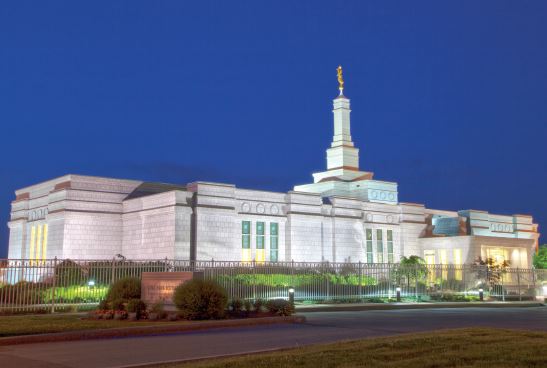 The Halifax Nova Scotia Temple, dedicated in 1999 by Gordon B. Hinckley, President of the Church, has been a great blessing to Church members in the Atlantic Provinces. (Arnon Livingstone)
The Halifax Nova Scotia Temple, dedicated in 1999 by Gordon B. Hinckley, President of the Church, has been a great blessing to Church members in the Atlantic Provinces. (Arnon Livingstone)
John MacLennan was released as the bishop of the Dartmouth Ward to serve as the temple’s first president, with counselors Alvin Nieforth and Charles Grant. MacLennan’s wife, Janet, served as temple matron, with Glenda Nieforth and Jenny Grant as her assistants.
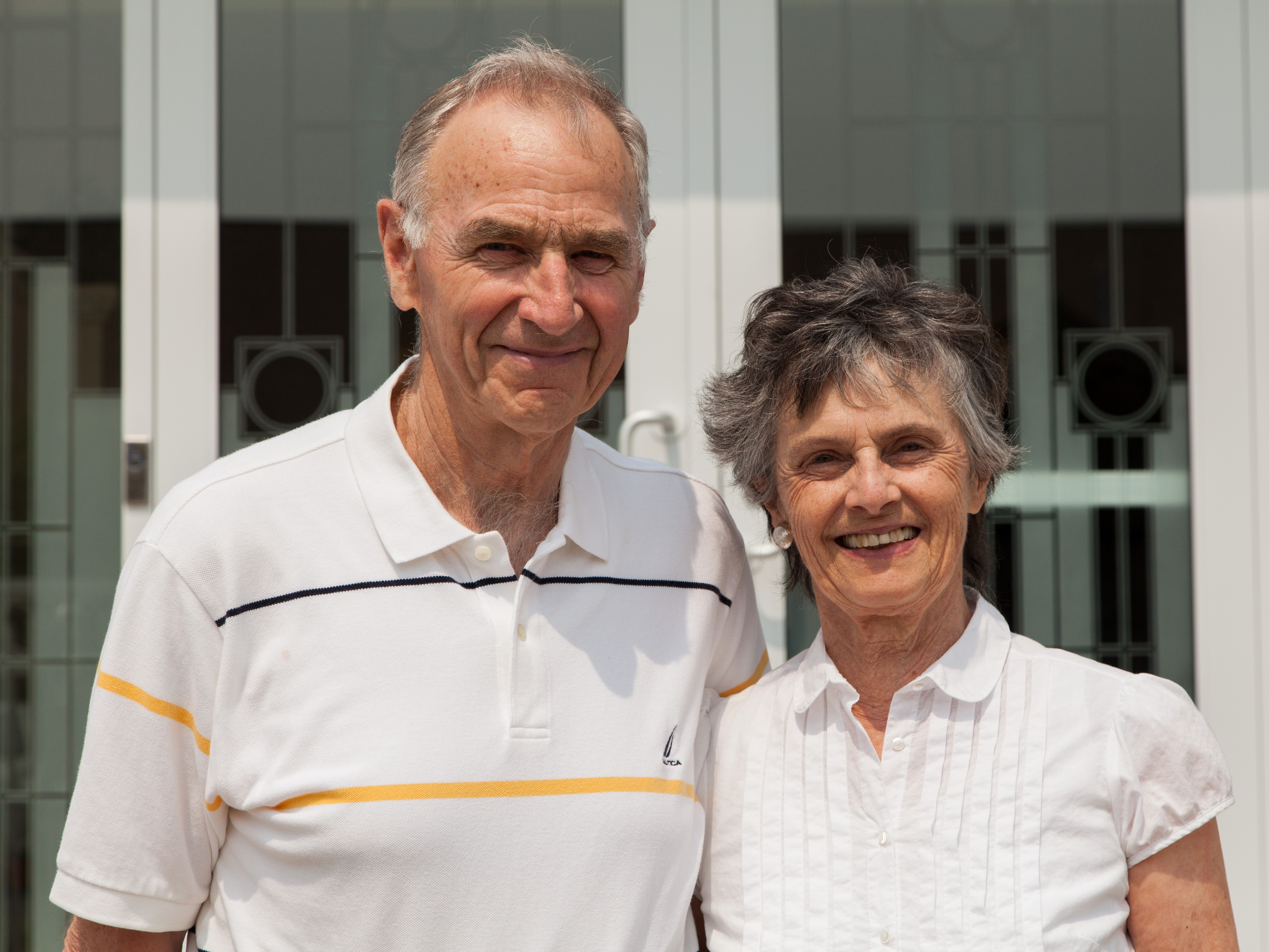 John MacLennan and Janet MacLennan of the Dartmouth Ward are shown here in 2014, some years after their service as the first president and matron of the Halifax Nova Scotia Temple. (Arnon Livingstone)
John MacLennan and Janet MacLennan of the Dartmouth Ward are shown here in 2014, some years after their service as the first president and matron of the Halifax Nova Scotia Temple. (Arnon Livingstone)
To Church members in Atlantic Canada, who had for years made significant sacrifices to travel to distant temples, the opening of the Halifax Nova Scotia Temple was a joyous and historic event. President Stephen Maxwell observed that in the period preceding the temple dedication, many Saints had become much more serious about having a current temple recommend, and that this blessed the lives of those individuals, their families, and the Church in the area.[218] For Rose Bruce of the Cole Harbour Ward, the blessings of having a temple close were deeply personal. She and her husband, Don, had joined the Church in 1979 and travelled to the temple in Washington, DC, three years later to be sealed as a family. In the years since then, two of her children had passed away and her husband had been diagnosed with dementia. For her, the temple had always represented being with family forever, so being able to see the temple on a regular basis was both a blessing and a comfort.[219] Lloyd Hart, a sealer who lived close to the temple, observed, “Thousands of missionaries have passed through here over the years. Many probably felt they made little difference. If they could see it now!”[220]
The temple has had a positive impact on the Church in the region. Ward and branch temple trips have been held regularly (at least twice each year for most units) and have served to bring units closer together. Missionaries and local leaders have worked together to take new members to the temple as soon after their baptisms as possible—often within a few months. Senior missionary couples that have come to serve in the temple have boosted the area. And, of course, it has been much easier for the members to visit the temple and, consequently, to be blessed by the experiences they have had there. When asked in 2014 about the effect the temple has had on the members of Atlantic Canada, John and Janet MacLennan stated that they, and many other people they know, have become more spiritual, more peaceful, and better able to handle life’s challenges as a result of faithfully attending the temple.[221]
Progress in the Church during that period after the temple dedication was marked by the establishment of the young single adult branch in Halifax in 2004[222] and by visits from Apostles Henry B. Eyring in 2004 and Jeffrey R. Holland in 2013.
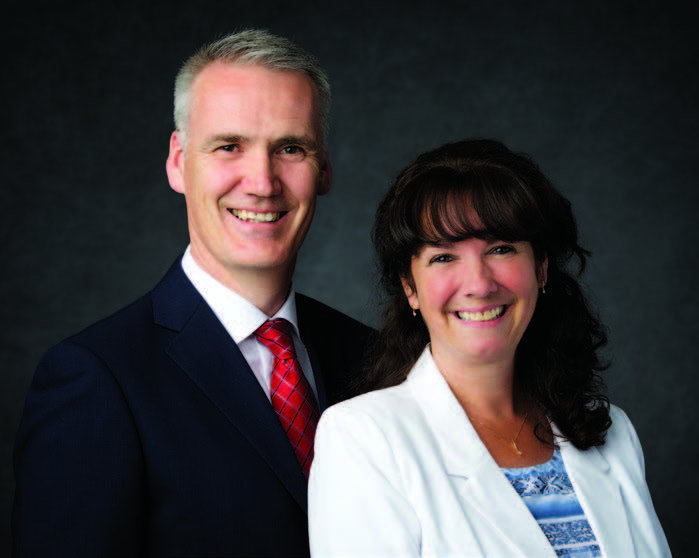 George and Lisa Pattison in 2016, when George became president of the Canada Edmonton Mission. He had previously served as president of the Saint John New Brunswick Stake from 2003 to 2012. (George Pattison)
George and Lisa Pattison in 2016, when George became president of the Canada Edmonton Mission. He had previously served as president of the Saint John New Brunswick Stake from 2003 to 2012. (George Pattison)
The Church and the Community
As the Church in Canada gained greater strength, it turned more toward community service. The Church has also hosted or organized several events that were well received by the public and helped raise awareness of the Church in the community, including a nativity play on the grounds of the Dartmouth Nova Scotia Stake Centre that has been an annual Christmas tradition for decades; Remembrance Day services in Kentville throughout the late 1980s and early 1990s; interfaith concerts held at the stake centre in Dartmouth in the 1980s; a visit from the BYU Young Ambassadors to various locations in the Maritimes in 1987; a special day of service in October 2012 that benefited many causes and communities across the region; a visit from world-renowned Harvard business professor and former Area Seventy, Clayton Christensen, who met with government, business, and academic leaders and spoke at a fireside for members in Dartmouth in July 2013; a series of well-attended musical concerts, referred to as the Orange Blossom Tour, performed by missionaries of the Canada Halifax Mission in 2013 and 2014; and a visit from the BYU–Idaho Sinfonietta, which performed to appreciative audiences in several cities and towns throughout the Maritimes in the spring of 2014.
Many Atlantic Saints have also engaged in great acts of service over the years. Members in St. John’s and Gander, for example, responded quickly and generously to help hundreds of people who had their planes diverted to Newfoundland as a result of the terrorist attacks of 11 September 2001. Some opened their homes for days to people who found themselves with no place to go as they waited for air travel to resume, and the St. John’s meetinghouse was made available to feed and house nearly two hundred people.[223]
Setbacks and Consolidation
The Church experienced many successes between 1994 and 2014, but it also experienced some setbacks. In several instances, the movement of Church members from the area, for economic or other reasons, led to discontinuance or consolidation of branches. There is also some suggestion that small branches were created in the 1970s when fuel prices and travel were an issue, and later the Church favoured consolidation of struggling units.
In Newfoundland, branches had to be closed in Grand Falls (2009), Marystown (2010), and Gander (2010). In Nova Scotia, branches closed in Barrington (2009), North Sydney (2011), Port Hawkesbury (2012), Liverpool (2012), and Windsor (2012). And in the Saint John New Brunswick Stake, branches closed in Woodstock (2008), Fort Kent (2009), and Island Falls (2011).[225] The New Glasgow District was discontinued on 6 November 2011 and, as a result, Prince Edward Island and the Amherst Branch were transferred back to the Saint John New Brunswick Stake, while the northern part of Nova Scotia returned to the Dartmouth Nova Scotia Stake.[226]
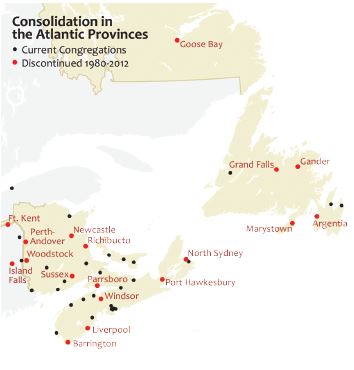
In addition, the membership growth rate declined dramatically. The average yearly growth rate in Atlantic Canada had been 6.3 percent between 1973 and 1993 (resulting in an increase of 4,942 members), but the rate fell to 0.92 percent per year from 1994 to 2015, far below the average Church growth rate of 2.83 percent for the period, providing for an increase of just 1,493 new members. All of the Atlantic Provinces showed modest gains during the period, but growth was slowest in New Brunswick with a net increase of just 191 additional members.[227]
A significant reason for the decline in that rate of growth is that many members had moved from the region to other areas with better job opportunities. Due in large part to a failing economy based on natural resources, the population of the Maritimes, according to a recent Globe and Mail article, has been falling since 2011.[228] This does not entirely explain the drop in Church membership, though. Keeping new members active in the Church has been a major challenge. Although new names were added each year to the membership rolls, most wards had not seen an increase in their average sacrament meeting attendance for several years.[229]
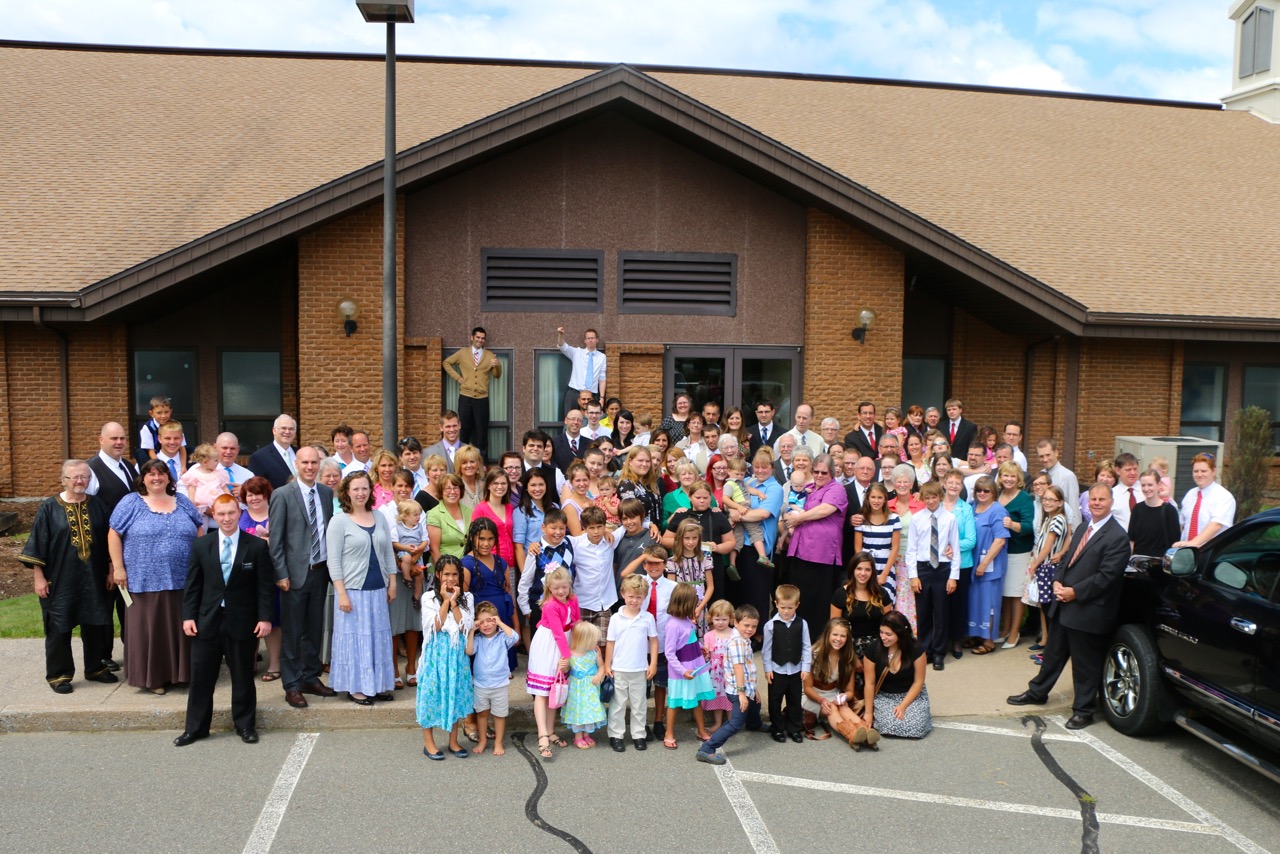 Group photo of the Saint John Ward, Saint John New Brunswick Stake, 20 August 2014, marking the eightieth anniversary of the organization of the Saint John Branch in 1934.
Group photo of the Saint John Ward, Saint John New Brunswick Stake, 20 August 2014, marking the eightieth anniversary of the organization of the Saint John Branch in 1934.
For the Church in Atlantic Canada to experience significant growth again, it will have to attract and retain committed new converts who are able and willing to make great contributions, just as the wave of new converts did who joined the Church in the 1970s and 1980s. It would also benefit greatly from an economic upturn in the region accompanied by an influx of Church members from other areas. According to the Conference Board of Canada’s 2015 economic forecast for the region, this may well be in the offing, due to a stronger US economy and a lower Canadian dollar, which are expected to boost manufacturing and exports.[230]
Challenges and Opportunities
The Church in Atlantic Canada continues to face some of the same challenges that it has always faced. One of the most significant of these is that some units are very large geographically but have few active members. When this is the case, it is difficult to run youth programs, hold activities, and conduct home and visiting teaching visits, let alone hold Sunday meetings. The Bathurst Branch in New Brunswick and the Corner Brook Branch in Newfoundland serve as excellent examples. Don and Sheila Pierson, who served as senior missionaries in Corner Brook, noted the following in 2005: “This branch covers all of Western Newfoundland and Labrador. There are presently 89 members on record, but a great many of them cannot attend meetings because of the distance.”[231]
Latter-day Saints in Atlantic Canada today are not persecuted in the way the early converts were, but they face their own challenges. In 2012, for example, a man published an article in a Fredericton newspaper, the Daily Gleaner, arguing that Latter-day Saints are not Christians—to which George Pattison, then president of the Saint John New Brunswick Stake, responded.[232] Although this kind of attack does not happen very often, beliefs are questioned and sometimes mocked by neighbours and coworkers.
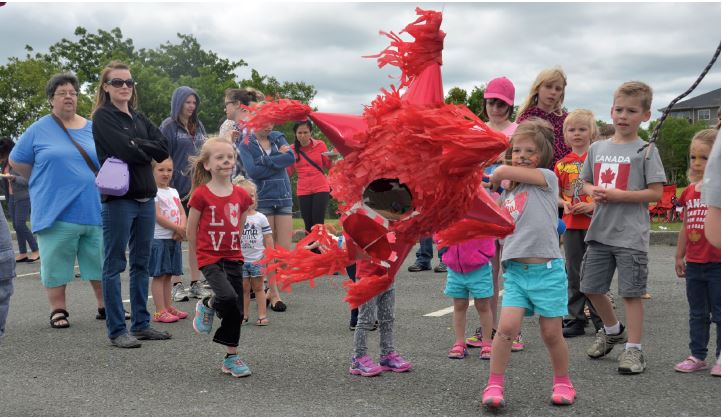 In Newfoundland, children attempt to break a piñata at a Canada Day event of the St. John’s Branch on 1 July 2015. (Mandy Harline)
In Newfoundland, children attempt to break a piñata at a Canada Day event of the St. John’s Branch on 1 July 2015. (Mandy Harline)
The bigger challenge for the Church in Atlantic Canada today is that people in the region are rapidly losing interest in organized religion, just as they are across the country. In 1971, only 2 percent of people in Atlantic Canada considered themselves nonreligious, but that number jumped to 16 percent by 2011. (The number for Canada as a whole was 4 percent in 1971 and 24 percent in 2011[233]). Plus, those who do consider themselves religious have become less committed. The number of people in Atlantic Canada who reported attending religious services at least once per month dropped from 57 percent in 1986 to 31 percent in 2011. This is a decrease of 26 percentage points over a twenty-five year period; for Canada as a whole, the number dropped by 16 percent over the same period.[234]
A Heritage of Faith
There certainly are reasons to be concerned about the health and growth prospects of the Church in Atlantic Canada in the years ahead. However, it is important to remember that Church members in Atlantic Canada have overcome great challenges before. Indeed, the Church in this area went from almost nothing in 1919 to having more than eight thousand members in 2015, dozens of beautiful meetinghouses, two stakes, and a temple within eighty years. And members today have fewer concerns and far more resources than the early Saints had. They no longer have to petition for the right to meet in public as Mark E. Petersen and his companions did when they arrived in Nova Scotia in the 1920s. Members today do not have to clean rented halls or contribute much of their time to fundraising efforts and additional money to building funds in the way members did from the 1940s to the 1980s. Unlike those who travelled to Cardston (Alberta); and then Washington, DC; and then Toronto to reach the nearest temple, most members now live within a few hours’ drive of the temple in Halifax.
As Latter-day Saints, from both inside and outside Atlantic Canada, study the history of the Church in this beautiful region, they can learn this very important lesson: you do not have to live in an area where the Church is large or well established for the gospel to have a profound effect on your life. Jesse Crosby; Joseph Russell; Marriner W. Merrill; Nelson and Edna Smith; Aubrey and Thelma Fielden; Wilbur and Gladys Moses; and Ralph and Gerda Waugh are just a few of the many great people from this region whose lives serve as a testament to this truth. Each of them has made great sacrifices and tremendous contributions, and each has testified that their lives were made better because of their devotion to the gospel of Jesus Christ.
Notes
[1] The author has benefitted greatly from the work of Carma Prete, who did extensive research on the Atlantic provinces while serving a full-time mission at the Church History Library from 2013 to 2016. The author likewise expresses sincere appreciation to Terry and Arnon Livingstone, who travelled to Atlantic Canada in the summer of 2014 as Church service missionaries, who conducted approximately fifty oral history interviews, took photographs, and collected historical materials.
[2] “Learn About New Brunswick,” Government of Brunswick, http://
[3]“Halifax, Nova Scotia,” Weatherbase, http://
[4] “About the Island” Prince Edward Island: Canada, http://
[5] https://
[6] “Island Information,” Prince Edward Island: Canada, http://
[7] Leslie Harris and James Hiller, “Newfoundland and Labrador Province, Canada,” Encyclopedia Britannica, http://
[8] “Military Bases,” Heritage: Newfoundland & Labrador.
[9] Historian’s Office Histories of the Twelve, 1856–58, 1861, Lyman E. Johnson, 1857, CR 100 93, box 1, folder 5, Church History Library, Salt Lake City (hereafter CHL). The record leaves some ambiguity as to whether the mission was in 1832 or 1833. Heriot, Herritt, Herrit, and Herrot, appear to be alternate spellings of the same name.
[10] Latter-day Saint Messenger and Advocate, July 1836, 352, CHL.
[11] “Marriner W. Merrill Reminiscences” (1888), 4–5, CHL, MS 11785 2. Merrill’s account, written in 1888, says that his mother was baptized by Elder John Herrit in 1834 or 1835. However, the Journal History clearly puts the visit of Lyman Johnson and his companions and the creation of the Sackville Branch in the spring of 1836. Journal History, vol. 16 (January–April 1836), 4 April 1836, and vol. 17 (May–December 1836), 26 June 1836, CHL.
[12] See Grant L. Nielsen, Joseph Russell, Miramichi Shipbuilder and Financier (Brossard, Quebec: G. L. Nielsen, 1980), 1–20ff.
[13] Melvin Clarence Merrill, Utah Pioneer and Apostle Marriner Wood Merrill and His Family (Marriner Wood Merrill Heritage Committee, 1937), 34.
[14] “Journal of Jesse Crosby,” 25–27, CHL, MS 24036; Benjamin Brown, Testimonies for the Truth: A Record of Manifestations of the Power of God, Miraculous and Providential, Witnessed in the Travels and Experience of Benjamin Brown, High Priest in the Church of Jesus Christ of Latter-day Saints, Pastor of the London, Reading, Kent and Essex Conferences (Liverpool: S. W. Richards, 1853), 21–23, CHL. The location of this mob violence (Southampton) is noted in Eliza S. Keeler Autobiography and Journal, 1840–1909, 6–10, CHL, MS 188.
[15] John Ellison Maxfield, KWJC-QHH, www.familysearch.org.
[16] Joan S. Hamblin, “Voyage of the ‘Brooklyn,” Ensign, July 1997, 16–19.
[17] Halifax Branch Record, 1843–54, 10 December 1845 and 31 May 1847, CHL, LR 3554 21.
[18] Joseph Millet journal and papers, 6 April 1853–14 Oct 1853, CHL, MS 22538; Eugene England, “Without Purse of Scrip: A 19-Year-Old Missionary in 1853,” New Era, July 1975, 20–29. See also “Joseph Millet: A Faithful Missionary,” in Madelyn J. Smith, Our Heritage: A Brief History of the Contributions of Our Family to the Growth of the Church of Jesus Christ of Latter-day Saints (Utah: Harold E. Cripps Family Organization, 1993), 69–71.
[19] Halifax Branch Record, entry of 28 January 1846, CHL, LR 3554 21.
[20] The branch was led by Joseph M. Weir. Halifax Branch Record, entry of 15 May 1846, CHL, LR 3554 21.
[21] John Ellison Maxfield, KWJC-QHH, www.familysearch.org. For information on Wilford Woodruff’s visit to the Maxfield families in PEI in 1949, see Wilford Woodruff Journal, ed. Scott G. Kenney, vol. 3 (1 January 1846–31 December 1850), 28–31 July 1849 and 1–2 August 1849, 472–74.
[22] Journal History, vol. 87 (September–October 1851), 22 September 1851, 7–8, CHL.
[23] John A. Jost was called on 14 December 1851 to serve as the branch president. Halifax Branch Record, entry of 24 August 1846, CHL, LR 3554 21.
[24] Journal History, vol. 89 (January–February 1852), entry of 1 January 1852, 1, CHL; “Journal of Jesse Crosby,” 88, CHL, MS 24036; Journal History, vol. 95 (October–December 1852), entry of 2 October 1852, 1–3, CHL.
[25] “Journal of Jesse Crosby,” 91–92, 23 October 1852–20 April 1853, CHL, MS 24036.
[26] John A. Jost Journal,12 May–29 May 1855, CHL, MS 910; The Mormon Pioneer Overland Travel: 1847–68 database (found at http://
[27] John A. Jost Journal, 1855 May–1856 January, CHL, MS 901. Jost’s journal records that the Middlemass and Green families and Abigail Priestly, who had still been in Halifax at the time Jost’s party departed, joined the Josts in St. Louis on 29 May 1855. According to The Mormon Pioneer Overland Travel database, the John Skerry family, who is also mentioned in the Halifax Branch record, is listed among the companies of LDS pioneers who went west, but it is not known when the Skerrys left Halifax; see http://
[28] Gordon D. Pollock, “Roads to Zion: The Mormons in Mid-Nineteenth Century Nova Scotia,” a lecture delivered to the Nova Scotia Genealogical Society, 25 September 1990, 4.
[29] Carma T. Prete identified the names of at least two hundred Church members from the Maritime provinces in the Mormon Pioneer Overland Travels database (History.lds.org/
[30] Census of Canada, 1871, Library and Archives Canada, http://
[31] Census of Canada, 1881, Library and Archives Canada, http://
[32] Census of Canada, 1871, Library and Archives Canada, http://
[33] Eliza S. Keeler Autobiography and Journal, 10, CHL, MS 188.
[34] Marriner W. Merrill Reminiscences, 4–5, CHL, MS 11785 2.
[35] Gordon D. Pollock, “‘Tin Hat’ on the Disciples of Brigham Young: Nova Scotians, Mormons, and Polygamy, 1920–1928,” Nova Scotia Historical Review 14, no. 1 (1994): 45, n10.
[36] “The Mormon Temple, South Rawdon,” photograph and information in the possession of West Hants Historical Society, Windsor, Nova Scotia. The deed was registered on 3 September 1889. In 1957, the land was purchased by the United Church of Canada.
[37] Elaine Ingalls Hogg, Historic Grand Manan: Images of Our Past (Halifax, Nova Scotia: Nimbus Publishing Limited, 2007), 19.
[38] Robert Dickson, Report of 6 August 1872, Missionary Reports, folder 23, item 1, CHL, MS 6104.
[39] Nova Scotia District General Minutes (hereafter NSDGM), Nova Scotia District, New England Mission, folder 1 (1920–25), 131, CHL, LR 6251 11; Eastern States Mission Elders Register, 1897–1901, folder 2, August 1897, CHL, CR 2475 9.
[40] New York New York South Mission Manuscript History and Historical Reports (hereafter NYNYSMMHHR), box 1, folder 4, report of 31 December 1906, CHL, LR 2475 2.
[41] NYNYSMMHHR, box 2, folder 1 (1910–12), 22 August 1911, CHL, LR 2475 2.
[42] Liahona, the Elders’ Journal 18, no. 5 (31 August 1920); 99, and vol. 18, no. 9 (26 October 1920): 172, CHL. Stephens is known as “George” in the Liahona reference.
[43] NYNYSMMHHR, box 2, folder 2, 31 December 1914, CHL, LR 2475 2.
[44] NYNYSMMHHR, 23 March 1915, box 2, folder 3, CHL, LR 2475 2. See also Liahona, the Elders’ Journal, vol. 12:609 (16 March 1915).
[45] Liahona, the Elders’ Journal 17, no. 5 (2 September 1919): 83, and vol. 17, no. 18 (2 Mar. 1920): 304, CHL.
[46] Liahona, the Elders’ Journal 17, no. 11 (25 November 1919): 190, and no. 18 (2 March 1920): 304, CHL.
[47] Liahona, the Elders’ Journal 18, no. 2 (20 July 1920): 43, and vol. 18, no. 4 (17 August 1920): 77, CHL.
[48] Permission was granted again in 1923. Liahona, the Elders’ Journal 21, no. 4 (14 August 1923), 70, CHL.
[49] Liahona, the Elders’ Journal 18, no. 2 (20 July 1920): 43, CHL.
[50] Liahona, the Elders’ Journal, 18, no. 2, (20 July 1920), 43, and 18, no. 4 (17 August 1920): 77, CHL.
[51] Pollock, “‘Tin Hat’ on the Disciples of Brigham Young,” 42.
[52] The Most Reverend Clarendon L. Worrell to Alderman John S. Power, Chairman, Laws and Privileges Committee, City of Halifax, in Public Archives of Nova Scotia, RG 35-102, series 13, vol. 29, doc. 74, and quoted in Halifax Herald, 20 February 1920.
[53] Pollock, “‘Tin Hat’ on the Disciples of Brigham Young,” 47–48.
[54] Liahona, the Elders’ Journal, 18, no. 9 (26 October 1920), 173, CHL.
[55] Pollock, “‘Tin Hat’ on the Disciples of Brigham Young,” 58–60.
[56] Photo is from Mark E. Petersen Missionary Portraits, CHL, PH 3268.
[57] Liahona, the Elders’ Journal, 17, no. 23 (11 May 1920), 391, CHL.
[58] Henry L. Baker Journal, typescript, entry of 12 October 1920, 48, CHL, MS 19398; NSDGM, folder 1 (1920–25), 63 and 131, CHL, LR 6251 11.
[59] NSDGM, folder 1 (1920–25), 131, CHL, LR 6251 11.
[60] Mark E. Petersen missionary papers, 1 August 1921, CHL, MS 14625.
[61] NSDGM, folder 1 (1920–25), 132–34, CHL, LR 6251 11; Halifax Branch Sunday School minutes and records (hereafter HBSSMR), Halifax Branch, New England Mission, CHL, LR 3554 15; Liahona, the Elders’ Journal, 19, no. 8 (11 August 1921): 158, and 19, no. 10 (8 November 1921), 199, CHL.
[62] Mark E. Petersen Missionary Papers, July 19–26, 1920, CHL, MS 14625; Melvin B. Banner, Partners in a Promise: A Family History & Biography of Henry LeGrand Baker & Augusta Stegen Baker (North Salt Lake: DMT Publishing, 2007), 170–73, CHL. Banner refers extensively to Baker’s missionary journal and to letters Baker wrote to his wife.
[63] Henry L. Baker Journal, typescript, entry of 13 October 1920, 48, CHL, MS 19398.
[64] NSDGM, folder 1 (1920–25), 1926, 69, CHL, LR 6251 11.
[65] NSDGM, folder 2 (1925–32), 29–30, 7–10 September 1927, CHL, LR 6251 11.
[66] NSDGM, folder 1 (1920–25), 73, CHL, LR 6251 11.
[67] Liahona, the Elders’ Journal 19, no. 1 (5 July 1921): 19, CHL.
[68] Liahona, the Elders’ Journal 21, no. 13 (18 December 1923), 251, CHL.
[69] Liahona, the Elders’ Journal 19, no. 10 (8 November 1921); 199, vol. 21, no. 15 (15 January 1924): 291, and vol. 21, no. 15 (15 January 1924): 291, CHL. The first entry in the Halifax Sunday School minute book was made in November 1922. (HBSSMR, CHL, LR 3554 15.) NSDGM, folder 2 (1925–32), 19, entry of 2 February 1926, CHL, LR 6251 11. These women had been called to their Relief Society positions on 1 December 1925. [NSDGM, folder 2 (1925–32), 160, and folder 1 (1920–25), 50, CHL, 6251 11.]
[70] Liahona, the Elders’ Journal 23, no. 4 (11 August 1925), 78, CHL; NSDGM, folder 2 (1925–32), 12, entry of 25 June 1925, CHL, LR 6251 11.
[71] The Apostles who visited during these years were Joseph Fielding Smith, 1925 (NSDGM, folder 2 [1925–32], 12, 25 June 1925, CHL, LR 6251 11); Orson F. Whitney, 1926 (Liahona, the Elders’ Journal, 24, no. 4 [10 August 1926]: 90, CHL); David O. McKay, 1929 (Canadian District General Minutes (hereafter CDGM), Canadian District, New England Mission, 1926–39, 82, 27 May 1929, CHL, LR 12315 11); George F. Richards, 1930 (CDGM, 96–99, entry of 5 June 1930, CHL, LR 12315 11); Melvin J. Ballard, 1931 (CDGM, 122–24, 27–28 June 1931, CHL, LR 12315 11); George Albert Smith, 1932 (CDGM, 139–41, entry of 22–23 October 1932, CHL, LR 12315 11); Richard R. Lyman, 1934 (CDGM, 153–55, entry of 26–28 May 1934, CHL, LR 12315 11); Charles A. Callis, 1936 (CDGM, 161, entry of 16 June 1936, CHL, LR 12315 11); Joseph F. Merrill (CDGM, 173–74, 14–16 July 1937, CHL, LR 12315 11) and John A. Widtsoe (CDGM, 174, 16 and 25 September 1937, CHL, LR 12315 11), 1937; and Melvin J. Ballard, 1939 (CDGM, 180, 6 July 1939, CHL, LR 12315 11).
[72] Information obtained from the sources cited in the previous footnote.
[73] NSDGM, folder 2 (1925–32), 46–47, 28–29 May 1929, CHL, LR 6251 11.
[74] CDGM, 122–24, 27–28 June 1931, CHL, LR 12315 11.
[75] Elder Ballard visited on 27 May 1934. (CDGM, 153–55, entry of 26–28 May 1934, CHL, LR 12315 11.
[76] David E. Sheppard, The History of the Kentville Saints: Celebrating 35 Years of Organization as a Branch and a Ward (Kentville, Nova Scotia, 10 December 1996), 7.
[77] “A Message of Great Importance: A Flannelboard Story by Edna Smith Browne as Told to Marie F. Felt,” Instructor, November 1963, 397–98.
[78] CDGM, 143, entry of 16 March 1933, CHL, LR 12315 11.
[79] Liahona, the Elders’ Journal 31, 32, 33, and 34, (1933–36), CHL.
[80] CDGM, 152, 15 October 1933, CHL, LR 12315 11.
[81] Liahona, the Elders’ Journal 31, no. 11 (7 November 1933): 257, CHL.
[82] CDGM, 156–58, 12 August 1934, CHL, LR 12315 11.
[83] Leatha Boudreau Sisson, Fifty Three Years of Mormonism: Oh Say, What Is Truth (Lakeville, New Brunswick: Sisson Genealogical Publications), 1–9, CHL. Giggie died in 1939.
[84] Leatha Boudreau Sisson, Historical Collections of Mormonism in Northeast (Bristol, New Brunswick: Sisson Genealogical Publications, 1993), 50, CHL.
[85] Sisson, Historical Collections of Mormonism in Northeast, 50 and 74, CHL.
[86] Leatha Boudreau Sisson, A Career in the Royal Canadian Air Force, Pictorial (Woodstock, New Brunswick: Sisson Genealogical Publications, 1993), 44–45 and 60, CHL.
[87] Spurgeon J. Sisson, historical positions, Church Directory of Organizations and Leaders (CDOL), http://
[88] Saint John New Brunswick Stake Annual Historical Reports, folder 1, Sustaining List of 23 April 1995, CHL, LR 519391 3.
[89] Massachusetts Boston Mission Mission History 1937–52 (hereafter MBMMH), 3–4, September–October 1937, CHL, LR 6025 43; Liahona, the Elders’ Journal 35, no. 24 (24 May 1938), 565, CHL.
[90] Liahona, the Elders’ Journal, 36, no. 18 (28 February 1939), 420, CHL.
[91] MBMMH, Fourth Quarter 1940, 67, CHL, LR 6025 43.
[92] Canadian District Manuscript History and Historical Reports, Canadian District, New England Mission (hereafter CDMHHR), entry of 11 June 1940, CHL, LR 1352 2.
[93] MBMMH, Summer 1941, 77, CHL, LR 6025 43.
[94] MBMMH, 14 September and 15 November 1942, 115, CHL, LR 6025 43. This couple’s names are unknown.
[95] Ralph Waugh and others, A History of The Church of Jesus Christ of Latter-day Saints, Prince Edward Island, 1997, 2–4, CHL.
[96] Waugh, History of The Church, PEI, 5, CHL.
[97] Waugh, History of The Church, PEI, 3–4, CHL.
[98] MBMMH, 153, 18 January 1944, CHL, LR 6025 43.
[99] MBMMH, 168, 10 July 1944, CHL, LR 6025 43.
[100] MBMMH, 180–81, Fourth Quarter Report, 1944, 196, and Second Quarter Report, 1945, CHL, LR 6025 43.
[101] MBMMH, 208, Third Quarter Report, 1945, CHL, LR 6025 43.
[102] MBMMH, 225, May 1947, CHL, LR 6025 43.
[103] NSDGM, folder 3 (1935–47), 67, 8 July 1946, and 74, 8 February 1947, CHL, LR 6251 11.
[104] , NSDGM, folder 3 (1935–47), 76–77, entry of 23 March 1947, CHL, LR 6251 11.
[105] MBMMH, 307, entry of 6 July 1947, CHL, LR 6025 43; NSDGM, folder 3 (1935–47), 84, 4–5 July 1947, CHL, LR 6251 11. Coombs had for the past year been serving as president of the Nova Scotia Missionary District, but in July 1947 he became district president of both missionaries and members in Nova Scotia. See LR 6251 11, NSDGM, folder 3 (1935–47), 67, 8 July 1946, CHL, LR 6251 11.
[106] S. Dilworth Young was called as a member of the First Council of the Seventy in 1945 and continued to hold that calling during and after his term as President of the New England Mission. Deseret News 2013 Church Almanac (Salt Lake City: Deseret News, 2013), 139.
[107] MBMMH, 1–8 July 1949, 401, CHL, LR 6025 43.
[108] Interview of Evelyn May Roberts by Terry and Arnon Livingstone, conducted and recorded on 26 July 2014 in Cole Harbour, Nova Scotia, CHL, OH 7143.
[109] Sheridan R. Sheffield, “Halifax: Hub of Church Activity,” Church News, 27 February 1993, 11 and 13.
[110] Interview of Gladys Mae Moses by Terry and Arnon Livingstone, conducted and recorded on 18 June 2014 in Cole Harbour, Nova Scotia, CHL, OH 8658.
[111] Halifax Branch Manuscript History and Historical Reports, Halifax Branch, New England Mission (hereafter HBMHHR), CHL, LR 3554 2; “Church Officer Turns Sod for Mission Edifice,” Deseret News, Church Section, 12 July 1958, 4.
[112] Deseret News 2013 Church Almanac, 449.
[113] MBMMH, 373, 31 December 1948, CHL, LR 6025 43.
[114] Sisson, Historical Collections of Mormonism in Northeast, 60.
[115] Dedication Service of the Saint John Branch of the Church of Jesus Christ of Latter-day Saints, 16 October 1955, CHL, M255.86 S143n 1955.
[116] Fredericton Branch Manuscript History and Historical Reports (hereafter FBMHHR), entry of 30 May 1954, CHL, LR 3015 2.
[117] Dedication Service of the Saint John Branch, 16 October 1955, CHL, M255.86 S143n 1955.
[118] Sisson, Historical Collections of Mormonism in Northeast, 64.
[119] David Spragg, president of the Saint John New Brunswick Stake, telephone conversation with Roy A. Prete, 8 March 2017.
[120] MBMMH, 30 September 1949, quoting from letters, First Presidency to S. Dilworth Young, 2 July 1948, S. Dilworth Young to missionaries, 17 July 1948, letter, First Presidency to S. Dilworth Young, 10 August 1948, 358–69, 361, CHL, LR 6025 43.
[121] MBMMH, 30 September 1949, citing letters of 5–6, 14, and 22 August 1948, 359, 362–63, CHL, LR 6025 43.
[122] MBMMH, entry of 30 September 1949, 1–11 July 1949, 401, CHL, LR 6025 43.
[123] Newfoundland District General Minutes (hereafter NDGM), 7 July 1949, 1, CHL, LR 6066 11.
[124] NDGM, 24 September 1949, 13–14, CHL, LR 6066 11.
[125] NDGM, 7–10 August 1949, 4–5, CHL, LR 6066 11.
[126] NDGM, 5 October 1949, 15, CHL, LR 6066 11.
[127] NDGM, 20–24 August 1949, 5, CHL, LR 6066 11; NDGM, 5 October 1949, 14–15, CHL, LR 6066 11.
[128] NDGM, 29 August–14 September 1949, 6–7, CHL, LR 6066 11.
[129] NDGM, 14 January–5 February 1950, 21–23, CHL, LR 6066 11.
[130] MBMMH, 1937–52, 31 December 1948, citing letter of 29 December 1948, 375, CHL, LR 6025 43.
[131] MBMMG, 1937–52, 13 August 1950, 437–38, CHL, LR 6025 43; NDGM, of 13 August 1950, 33–35, CHL, LR 6066 11.
[132] Newfoundland Missionary Record, 20 April, 14 September 1963, CHL, LR 6025 39.
[133] NDGM, 5 and 9 February, 27 May, 26 November, 29 November–2 December 1951, 49–50, 66, 94–96, CHL, LR 6066 11.
[134] NDGM, 25 and 26 January; 7, 11 and 18 March; and 1, 8, 15, and 29 April 1951, 46–48, 56, 59, 60, 62–64, CHL, LR 6066 11.
[135] NDGM, 3 and 10 August, 6 September, and 31 October 1952, 113, 117–18, 121, CHL, LR 6066 11.
[136] Goose Bay Air Force Group Manuscript History and Historical Reports, November 1954 – December 1975, CHL, LR 3303 2.
[137] NDGM, 26–29 October 1954, 145, CHL, LR 6066 11.
[138] NDGM, 6 February 1957, 222–23, CHL, LR 6066 11.
[139] Prince Edward Island Missionary Record (hereafter PEIMR), 5 July, 14 November 1958, and September 1959, CHL, LR 6025 40.
[140] Maritime District Manuscript History and Historical Reports (hereafter MDMHHR), 1961, CHL, LR 5298 2; Maritime District Correspondence (hereafter MDC), folder 1, CHL, LR 14475 21.
[141] MDMHHR, 1961, 5, 25 July 1961, CHL, LR 5298 2; MDC, folder 1, letter, John E. Carr, Mission President, to All Saints in the Maritime District, subject: Organization of the Maritime District, 21 June 1961, CHL, LR 14475 21.
[142] Bridgewater Ward, New Glasgow Branch, and Sydney Branch, Historical Information, CDOL, http://
[143] MDC, folder 1, letter, Lewis D. Robbins to Walter Eugene Fellows, 12 December 1961, CHL, LR 14475 21. See also folder 1, letter, I. A. Terry to Lewis D. Robbins, 14 December 1961, CHL.
[144] Canada Halifax Mission Annual Historical Reports (hereafter CHMAHR), historical events 2006, report of 31 December 2006, CHL, LR 13514 3, 2006.
[145] MDC, folder 1, 22 July 1961, CHL, LR 14475 21.
[146] Sheppard, History of Kentville Saints, 15.
[147] MDC, folder 1, CHL, LR 14475 21.
[148] Sheridan R. Sheffield, “Halifax: Hub of Church Activity,” Church News, 27 February 1993, 11 and 13.
[149] Sheffield, “Halifax: Hub of Church Activity,” Church News, Feb. 27, 1993, 11 and 13; Jane Anne MacKinnon, “Saints in Halifax,” Ensign, April 1991, 78–79.
[150] Sheffield, “Halifax: Hub of Church Activity,” Church News, Feb. 27, 1993, 11 and 13.
[151] Janet MacLennan, “From Despair to Devoted Purpose,” https://
[152] Waugh, History of The Church, PEI, 7–8, CHL, M277.17 H673 1997.
[153] “Ralph Samuel Waugh 1925-2008,” http://
[154] Thomas P. Bolton autobiography, 1989–1993, 2–9, CHL, MS 21870.
[155] MDMHHR, Quarterly Historical Report of 31 March 1965, 17 January 1965, CHL, LR 5298 2.
[156] Saint John Brunswick Branch General Minutes, 1914–1976 (hereafter SJBBGM), 16 July 1967, CHL, LR 12516 11.
[157] Moncton Ward, Saint John New Brunswick Stake, Historical Information, CDOL, last modified 26 June 2013, http://
[158] Truro Branch, Historical Information, CDOL, last modified 16 October 2013, http://
[159] Goose Bay Air Force Group Manuscript History and Historical Reports, 31 December 1968, CHL, LR 3303 2.
[160] Summerside Branch Manuscript History and Historical Reports, 31 December 1969, CHL, LR 8805 2,
[161] Dartmouth Ward, Historical Information, CDOL, last modified 1 July 2013, http://
[162] Goose Bay Air Force Base, mh&hr, 31 December 1968, 31 December 1975, CHL, LR 3303 2; NDGM, 14 January – 5 February 1950, 31 August 1952, CHL, LR 6606 11.
[163] Deseret News 2013 Church Almanac, 449.
[164] FBMHHR, 31 December 1968, CHL, LR 3015 2.
[165] Gander Branch History of the Church in Gander and Grand Falls, Newfoundland (hereafter GBH), folder 3, 12, CHL, LR 161764 21.
[166] Canada Halifax Mission, General Information, CDOL, last modified 19 June 2013, http://
[167] Dean Perkins (of the Member and Statistical Records Division, The Church of Jesus Christ of Latter-day Saints), email to Barbara Hafen, Country Profile manager, CHL, 8 July 2014.
[168] https://
[169] lds.org/
[170] Sisson, Historical Collections of Mormonism in Northeast, 161, CHL, M277.15 S623h 1933.
[171] Waugh, History of The Church, PEI, 13-14, CHL, M277.17 H673 1997. The groundbreaking ceremony took place on 16 October 1982 and an open house was held on 18 June 1983. President David Sorensen of the Canada Halifax Mission dedicated the building on 10 November 1985.
[172] GBH, folder 3, 12, CHL, LR 161764 21.
[173] SJBBGM, 26 April, 13 June, 5 July, 7 July, 7 August, 29 November 1975, CHL, LR 12516 2. This record of the St. John’s (Newfoundland) Branch is incorrectly included with the records of the Saint John (New Brunswick) Branch.
[174] Sheppard, History of Kentville Saints, 36.
[175] Terry Livingstone, interview with Matt Heiss, 25 February 2014, Salt Lake City, CHL, OH 8676; conversation of Terry Livingstone with Roy Prete, August 2014.
[176] Distances were calculated using Google Maps’ “map driving route” feature available at http://
[177] Yarmouth Branch, Historical Information, CDOL, last modified 7 October 2013, http://
[178] CHMAHR, report for 2006, CHL, LR 13514 3; Corner Brook Branch Historical Information, CDOL, http://
[179] Woodstock Branch Annual Historical Reports, 8 June 1980, CHL, LR 21239 3; Woodstock Branch Historical Information, CDOL, http://
[180] Bathurst Branch Annual Historical Reports, 27 July 1980, CHL, LR 21304 3.
[181] GBH, 7–8, CHL, LR 161764 21.
[182] Prince Edward Island District Annual Historical Reports (hereafter PEIDAHR), 5 July 1981, CHL, LR 21028 3.
[183] Richibucto Branch, Argentia Branch, Greenwood Branch, Windsor Branch, and Annapolis Royal Branch, Historical Information, CDOL, http://
[184] CHMAHR, report for 2006, CHL, LR 13514 3; St. John’s Branch Historical Information, CDOL, http://
[185] St. John’s Branch Historical Information, CDOL, http://
[186] New Glasgow Nova Scotia District Annual Historical Reports, 30 March 1980, CHL, LR 21059 3.
[187] Halifax Nova Scotia District, Historical Information, CDOL,http://
[188] PEIDAHR, 13 April 1980, CHL, LR 21028 3.
[189] Charlottetown Branch Historical Information, CDOL, http://
[190] Nova Scotia North District Annual Historical Reports, Historical Record, Section B—Historical Events, 1983, 10 October 1983, CHL, LR 21027 3.
[191] CHMAHR, Historical Events 1985, folder 2, 12 May 1985, CHL, LR 13514 3.
[192] MDMHHR, Historical Events for 1977, 26–27 November 1977, CHL, LR 5298 2.
[193] CHMAHR, Historical Events 1986, folder 2, 12 February 1986, CHL, LR 13514 3.
[194] CHMAHR, Historical Events 1986, folder 2, 7 March 1986, CHL, LR 13514 3.
[195] Cole Harbour Ward, Historical Information, CDOL, http://
[196] “‘Bishop Moses’ could apply to father or son,” Church News, 27 February, 1993, http://
[197] Sackville Ward, Historical Information, CDOL, http://
[198] Interview of Gilbert Smith and Ann Smith, conducted and recorded by Terry and Arnon Livingstone on 14 July 2014 in Cole Harbour, Nova Scotia.
[199] Newcastle Branch Historical Information, CDOL, http://
[200] CHMAHR, 1979–2008, 6 November 1987 and 17 June 1988, CHL, LR 13514 3.
[201] CHMAHR, 1979–2008, 24–26 June 1988, CHL, LR 13514 3.
[202] SJNBSAHR, folder 1, 1989, 16 April 1989, and newspaper clipping inserted into record, “Blaine Hatt Sustained As Stake President,” Daily Gleaner, Saturday, 2 July 1988, 27, CHL, LR 519391 3; CHMAHR, 1979–2008, 26 June 1988, CHL, LR 13514 3.
[203] New Glasgow Nova Scotia District, Historical Information, CDOL, http://
[204] The following are some of the families that joined the Church in Nova Scotia in the late-1970s and that went on to hold prominent Church callings: Wayne and Karen Morgan (baptized in 1974), Greg and Sandra Ross (1976), Harvey and Aileen Priest (1977), Roy and Hilda Fox (1977), Lloyd and Cynthia Hart (1978), Michael and Sandra Choo (1978), and Rose and Don Bruce (1979).
[205] Interview of Terry Lee Livingstone and Arnon Diane Livingstone, conducted and recorded by Matthew K. Heiss on 25 February 2014 in Salt Lake City, Utah, CHL, OH 8676. President Sorensen later served as a General Authority from 1992–2005, including as a member of the Presidency of the Seventy from 1998–2005. He passed away in 2014. R. Scott Lloyd, “Elder David E. Sorensen, Emeritus General Authority, Dies at Home in California,” Church News, 29 August 2014, http://
[206] Interview of Terry and Arnon Livingstone, 25 February 2014, CHL, OH 8676.
[207] CHMAHR, 1979–2008, folder 3, 1987 report, 26 July 1987, CHL, LR 13514 3.
[208] Steve Fidel, “Small New LDS Temples to Dot the Globe,” Deseret News, http://
[209] Interview of Stephen Allen Maxwell and Pennylynn Maxwell, conducted and recorded by Terry and Arnon Livingstone on 13 April 2014 in Mesa, Arizona, CHL, OH 6862.
[210] Shaun D. Stahle, “Spirit of President Hinckley’s Visits Lingers,” Church News, 7 March 1998, http://
[211] Halifax Nova Scotia Temple, Folder Prepared for Temple Open House, 1999, CHL, M282.1 H173; “Locations for Six of 30 Small Temples Given,” Church News, 23 May 1998, http://
[212] Interview of Stephen Allen Maxwell and Pennylynn Maxwell, CHL, OH 6862.
[213] Interview of Stephen Allen Maxwell and Pennylynn Maxwell, CHL, OH 6862.
[214] Interview of Terry and Arnon Livingstone, 25 February 2014, CHL, OH 8676.
[215] Halifax Nova Scotia Temple Construction History, October and November 1998, CHL, CR 811 2.
[216] “Halifax Nova Scotia Temple,” Church News, 20 November 1999, 4.
[217] Shaun Stahle, “Historic Sabbath in Canada,” Church News, 20 November 1999, 3.
[218] Interview of Stephen Allen Maxwell and Pennylynn Maxwell, CHL, OH 6862.
[219] Interview of Rose Marie Bruce, conducted and recorded by Terry and Arnon Livingstone on 2 July 2014 in Cole Harbour, Nova Scotia, CHL, OH 7496.
[220] Shaun Stahle, “Distinguished as Doers and Dreamers,” Church News, 29 January 2000, http://
[221] Interview of E. A. John MacLennan and Janet MacLennan, conducted and recorded by Terry and Arnon Livingstone on 26 July 2014 in Cole Harbour, Nova Scotia, CHL.
[222] Halifax YSA Branch, Historical Information, CDOL, http://
[223] GBH, 17, CHL, LR 161764 21.
[224] Willis Walker, emails to Carma Prete, 3 October 2016 and 16 January 2017; David Ross, email to Carma Prete, 17 January 2017.
[225] Grand Falls Branch, Marystown Branch, Gander Branch, Barrington Branch, North Sydney Branch, Port Hawkesbury Branch, Liverpool Branch, Windsor Branch, Woodstock Branch, Fort Kent Branch, and Island Falls Branch Historical Information, CDOL, http://
[226] CDGM, 96–99, 5 June 1930, CHL, LR 12315 11.
[227] Based on Statistics provided by Dean Perkins, Membership and Statistical Records Division of The Church of Jesus Christ of Latter-day Saints, email to Stephen V. Beck, Country Profile manager, CHL, 28 March 2016; Tabulation of overall LDS Church rates of growth, by Carma T. Prete, 13 April 2016.
[228] John Ibbitson, “How the Maritimes Became Canada’s Incredible Shrinking Region,” Globe and Mail, 21 March 2015, http://
[229] Observation of author, who served for five years, 2010–15, as bishop of the Saint John New Brunswick Ward in the Saint John New Brunswick Stake.
[230] O. William Asplund, retired economist, email to Roy A. Prete, 29 March 2016, citing The Conference Board of Canada, Provincial Outlook-Winter 2015.
[231] CHMAHR, folder 2005, June 2005–December 2005, CHL, LR 13514 3.
[232] “Are the Mormons Christian?” Daily Gleaner, 30 January 2012, A6.
[233] “Canada’s Changing Religious Landscape,” Pew Research Center, 27 June 2013, http://
[234] “Canada’s Changing Religious Landscape,” Pew Research Center, 27 June 2013, http://
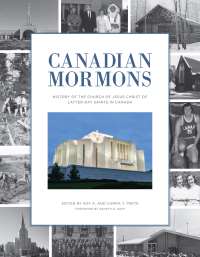
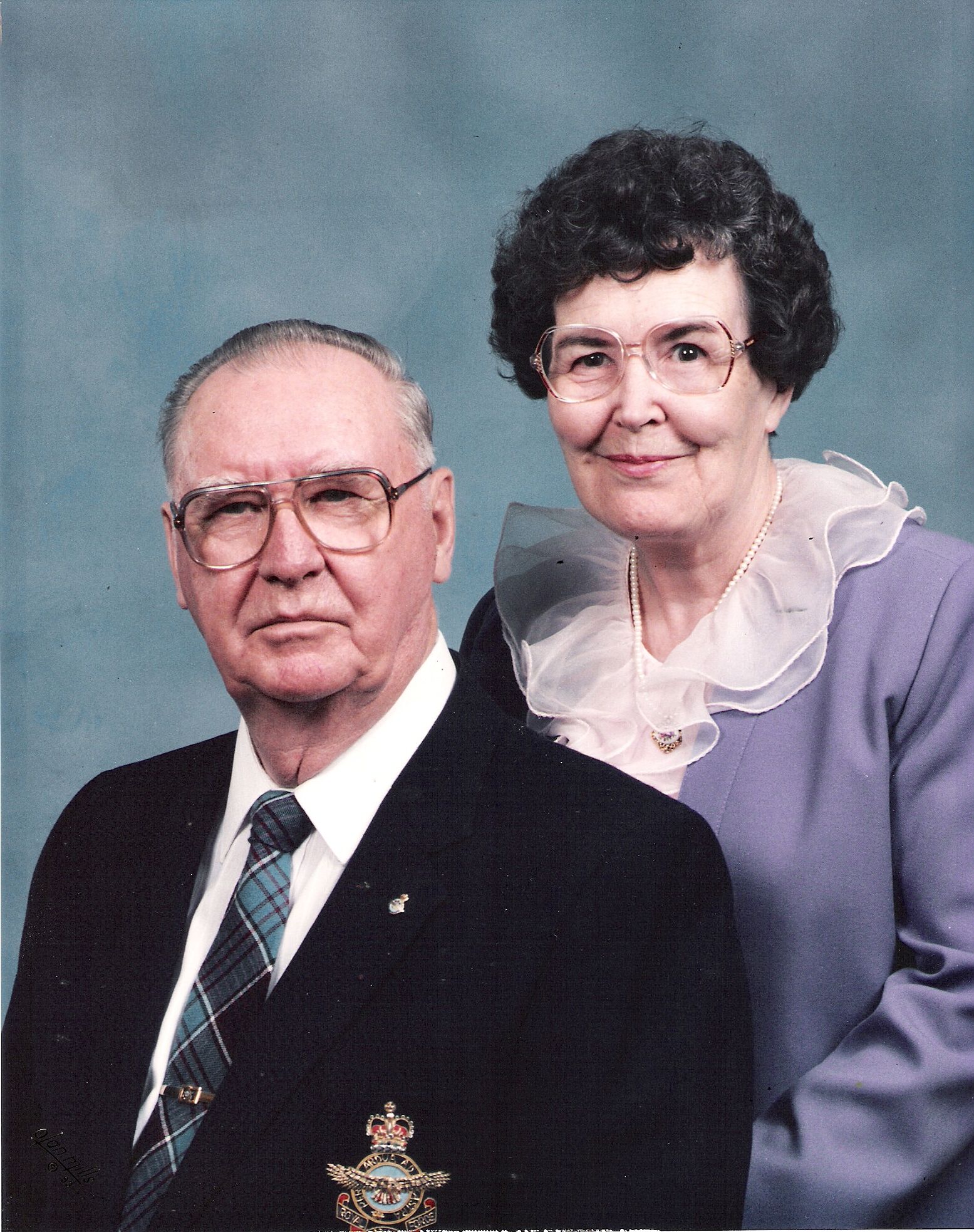 Spurgeon J. and Leatha Boudreau Sisson. (Maureen Theriault)
Spurgeon J. and Leatha Boudreau Sisson. (Maureen Theriault)